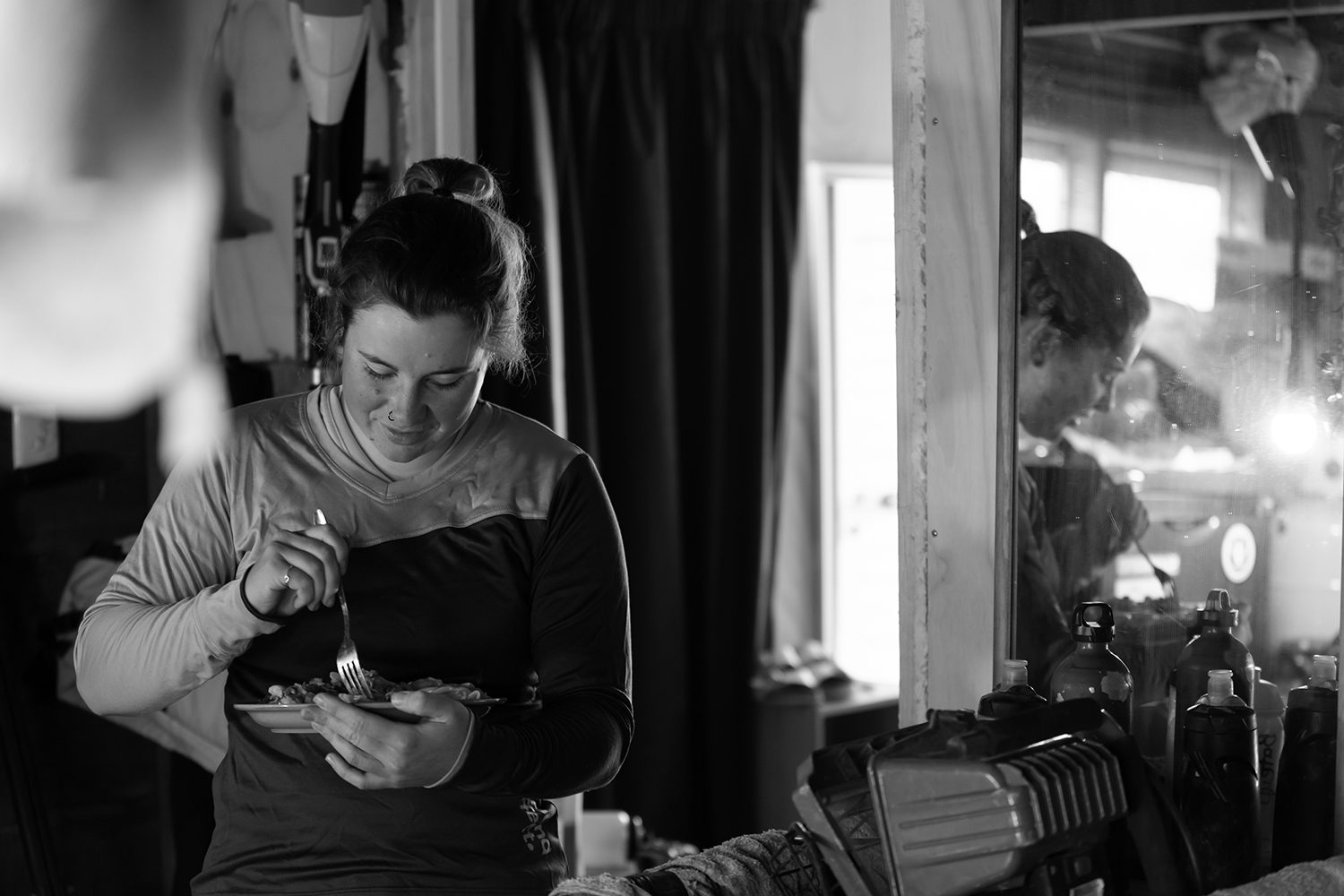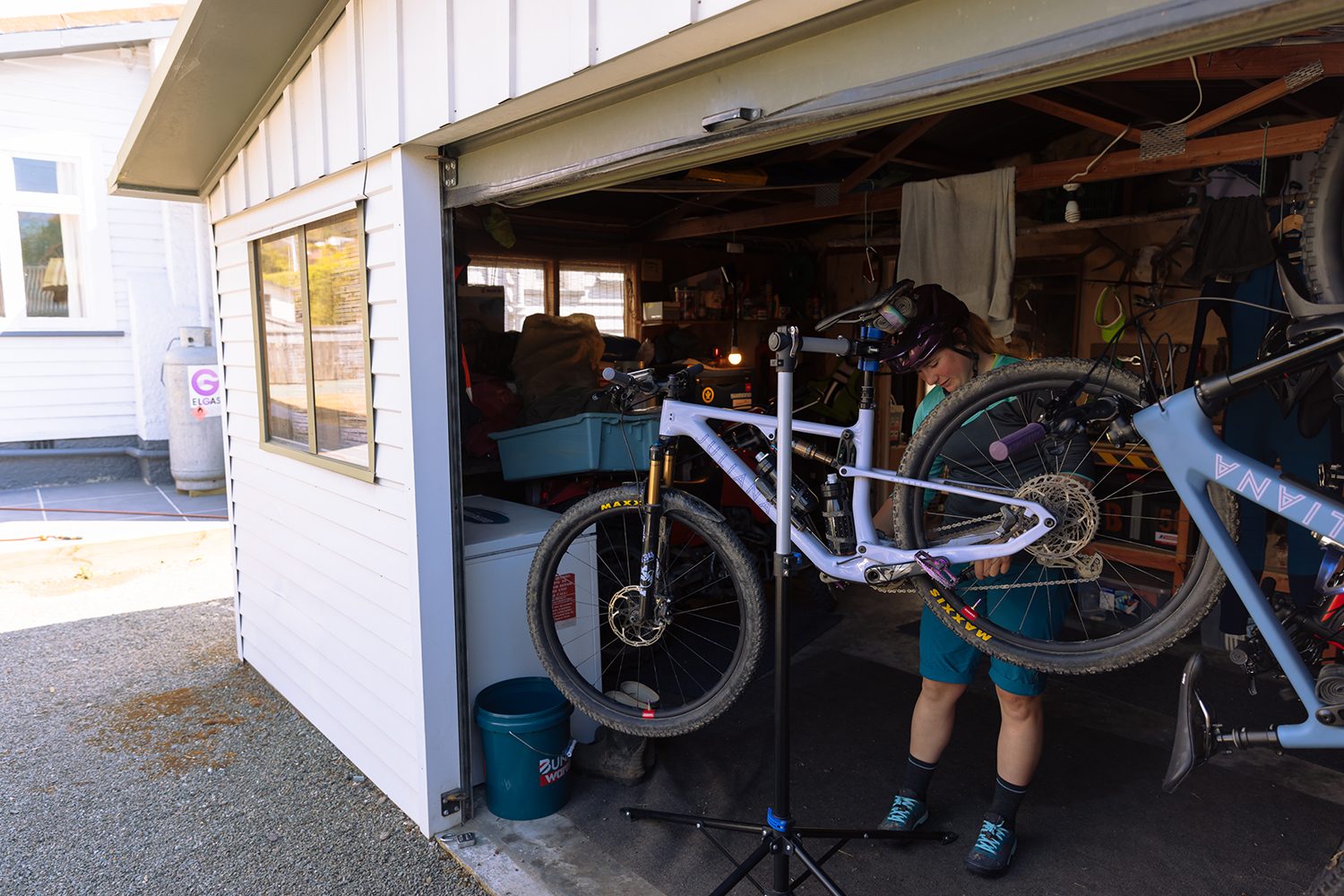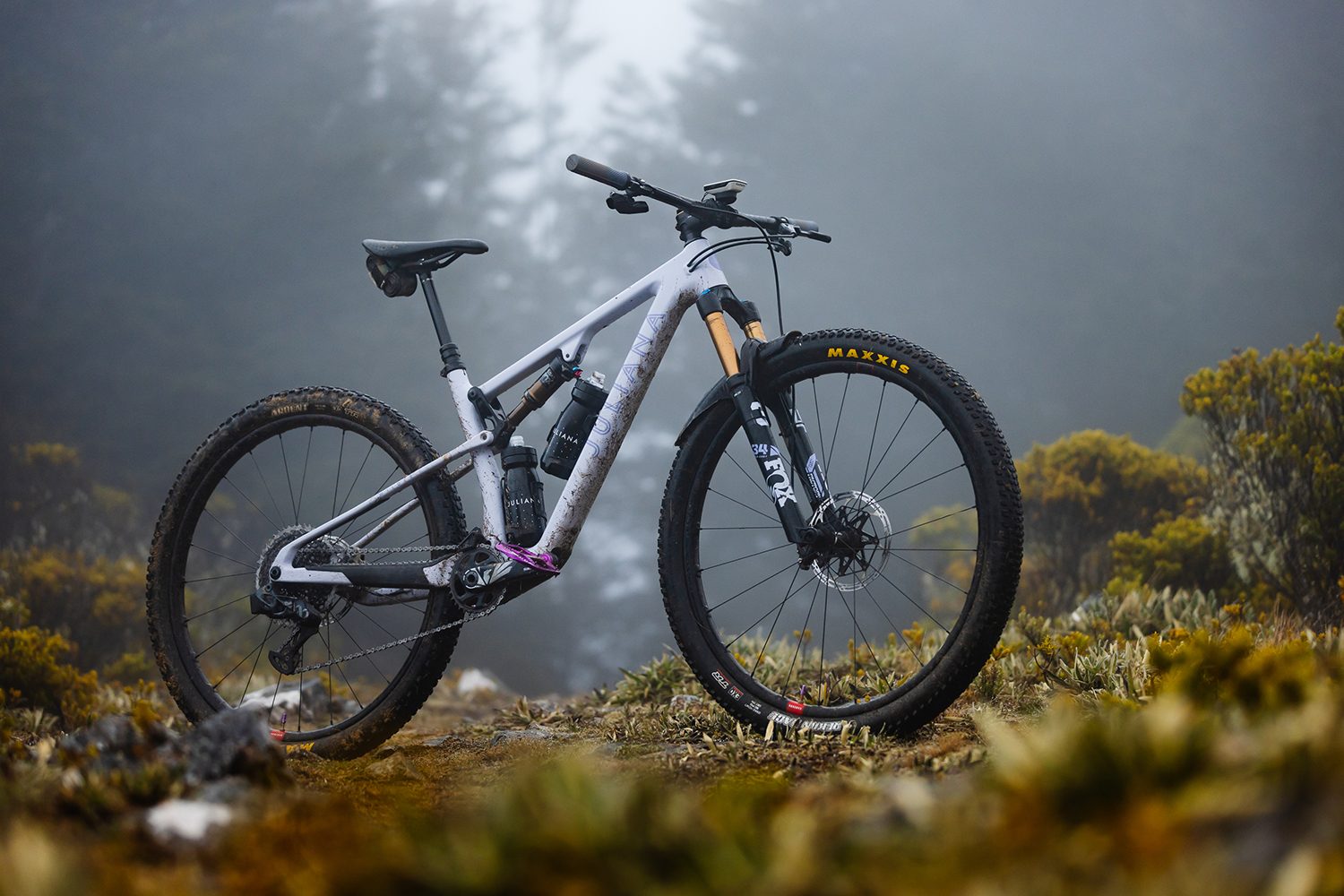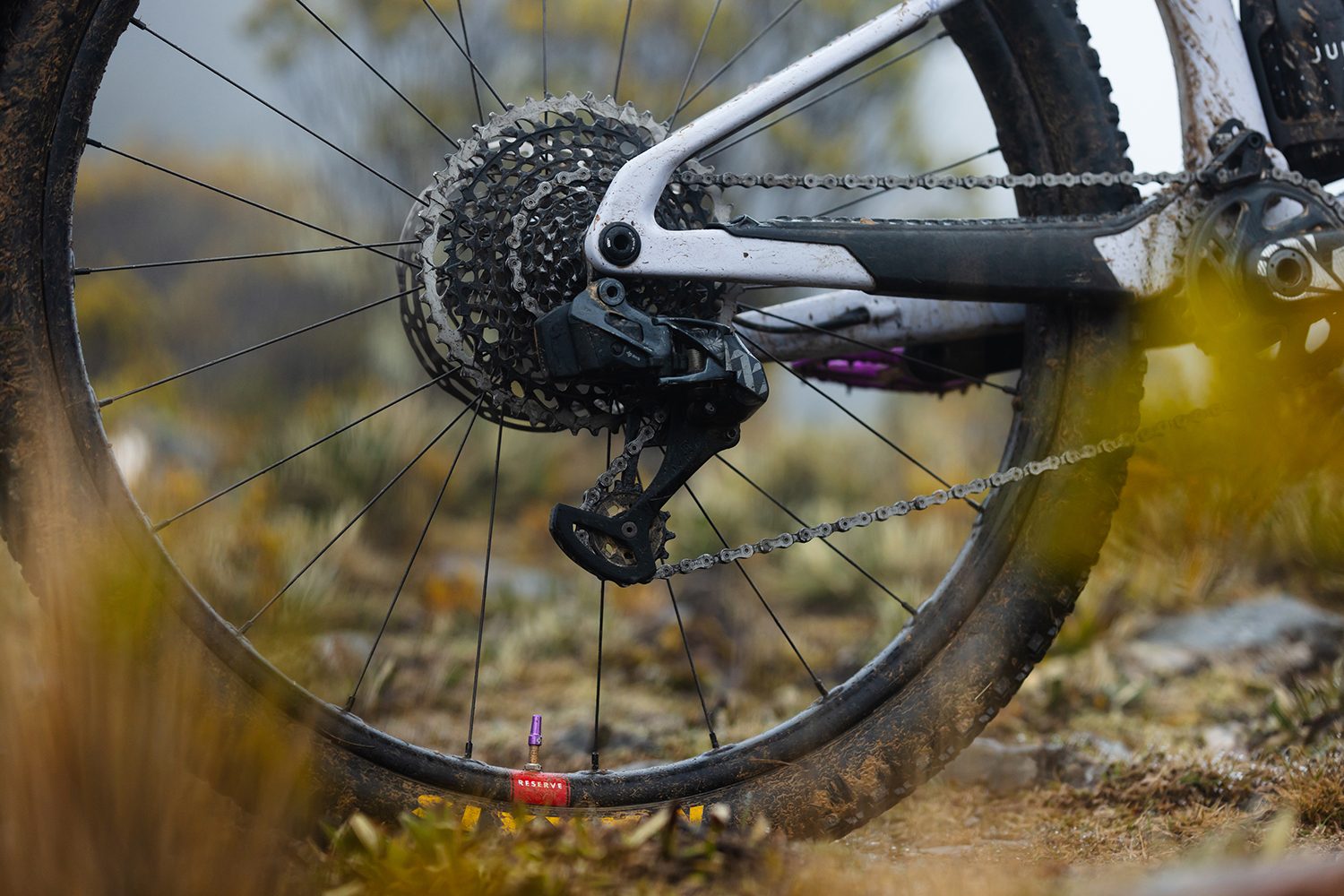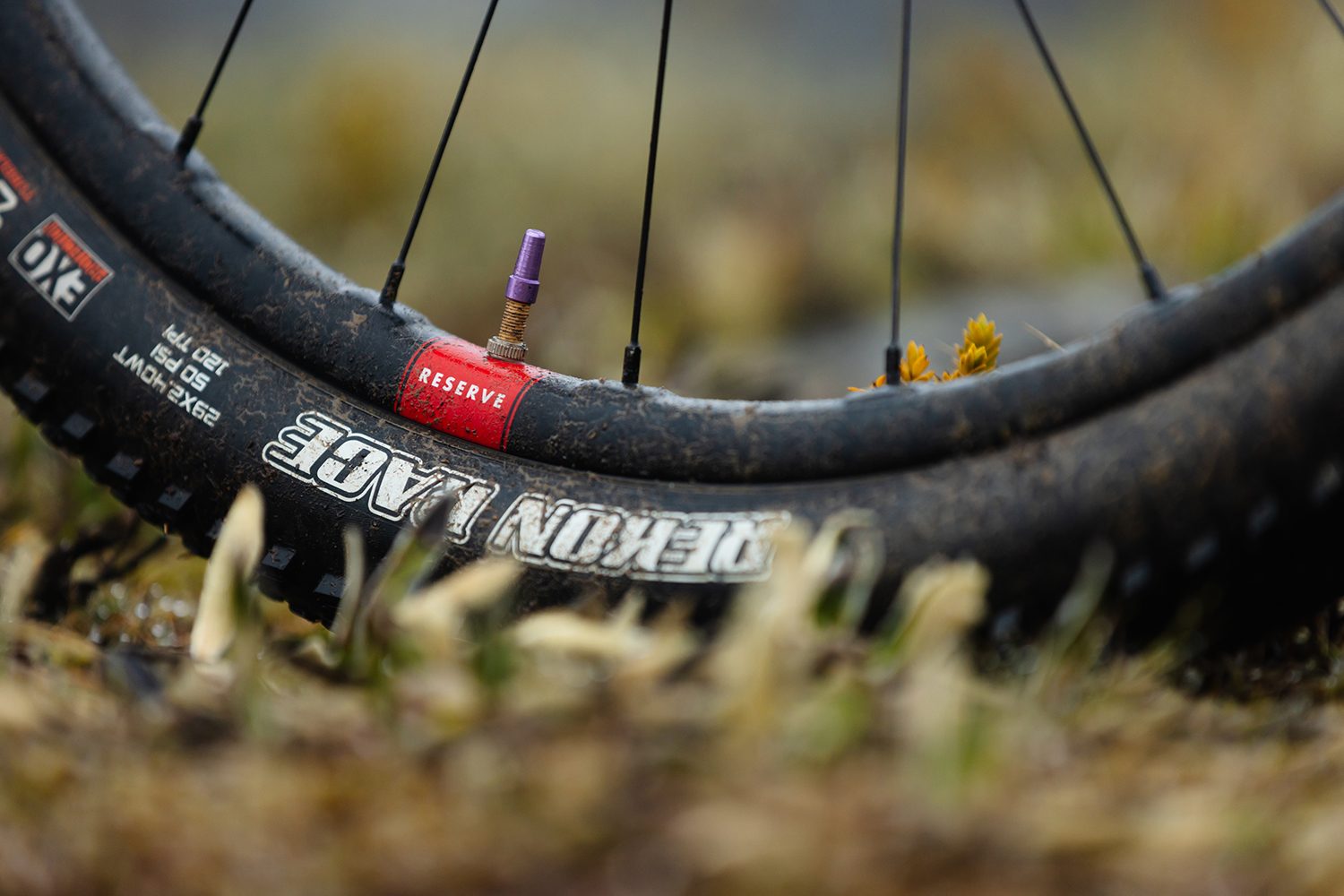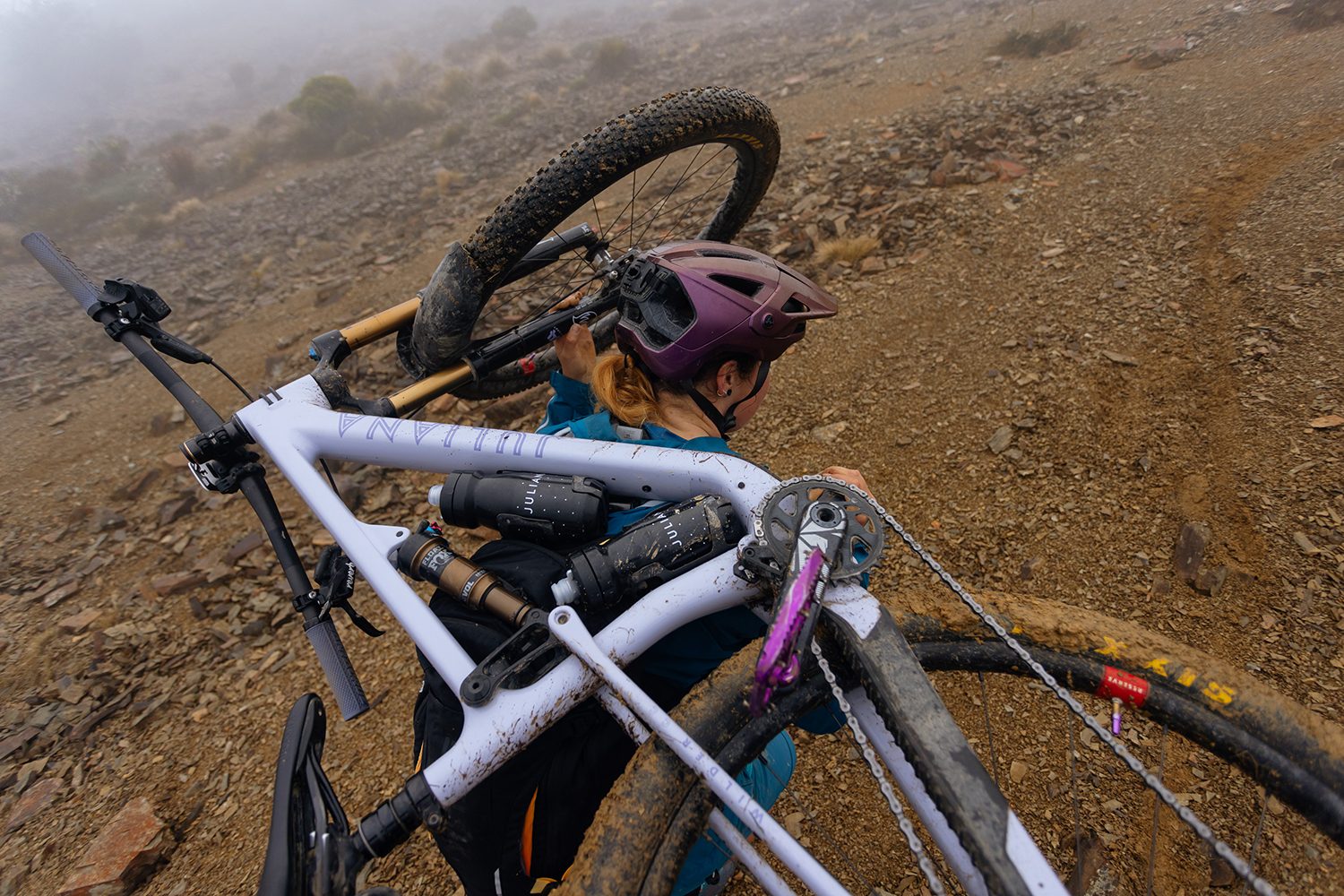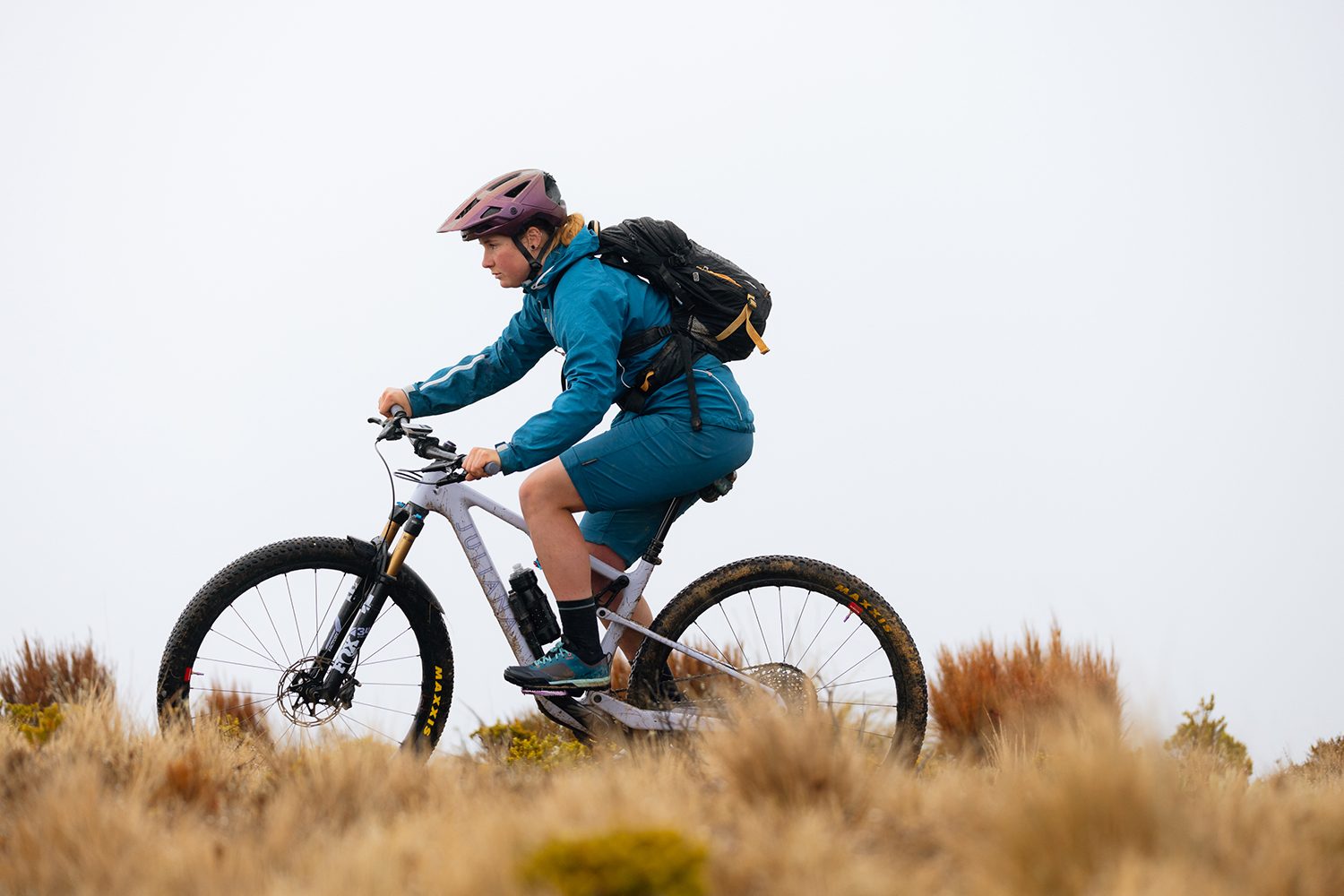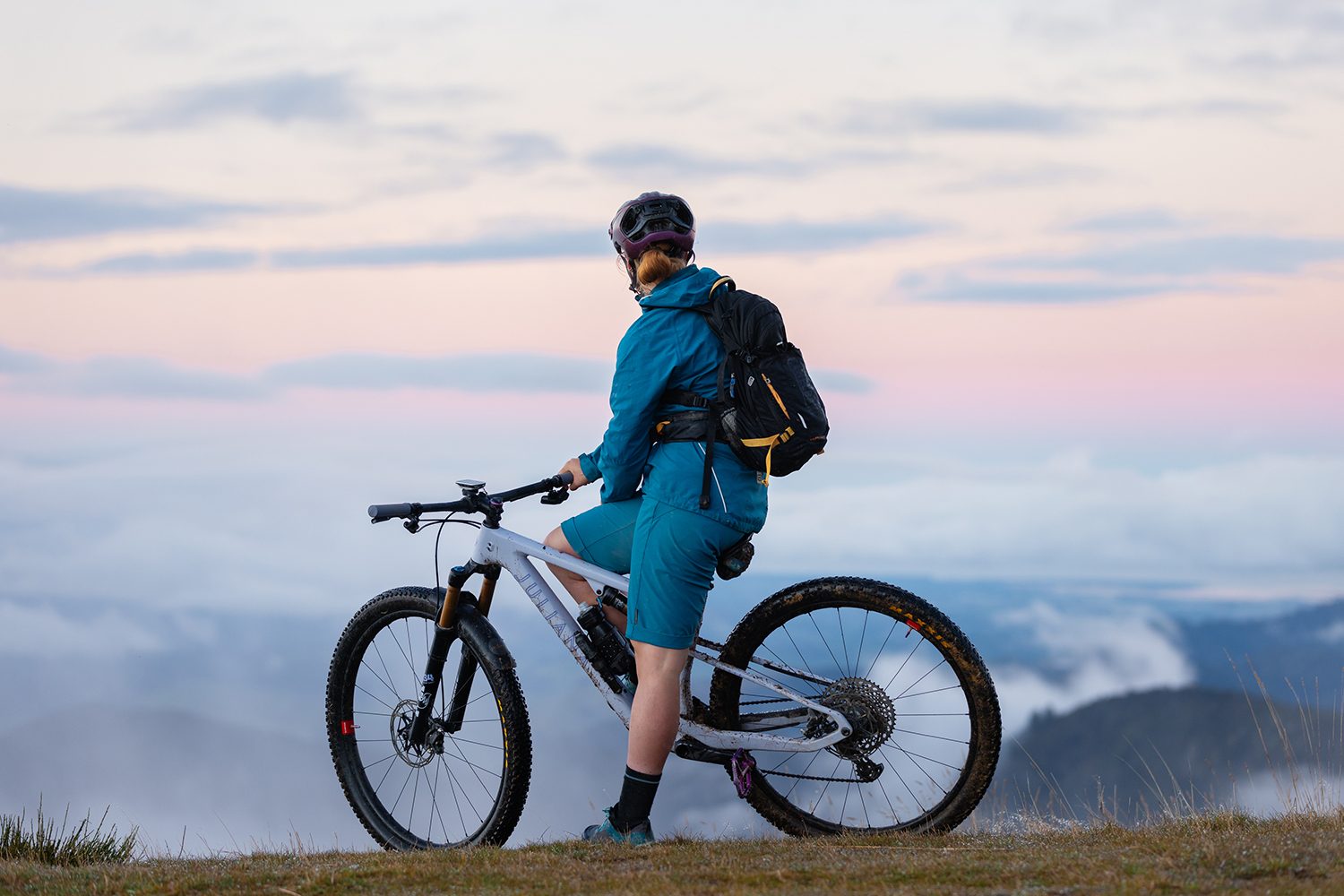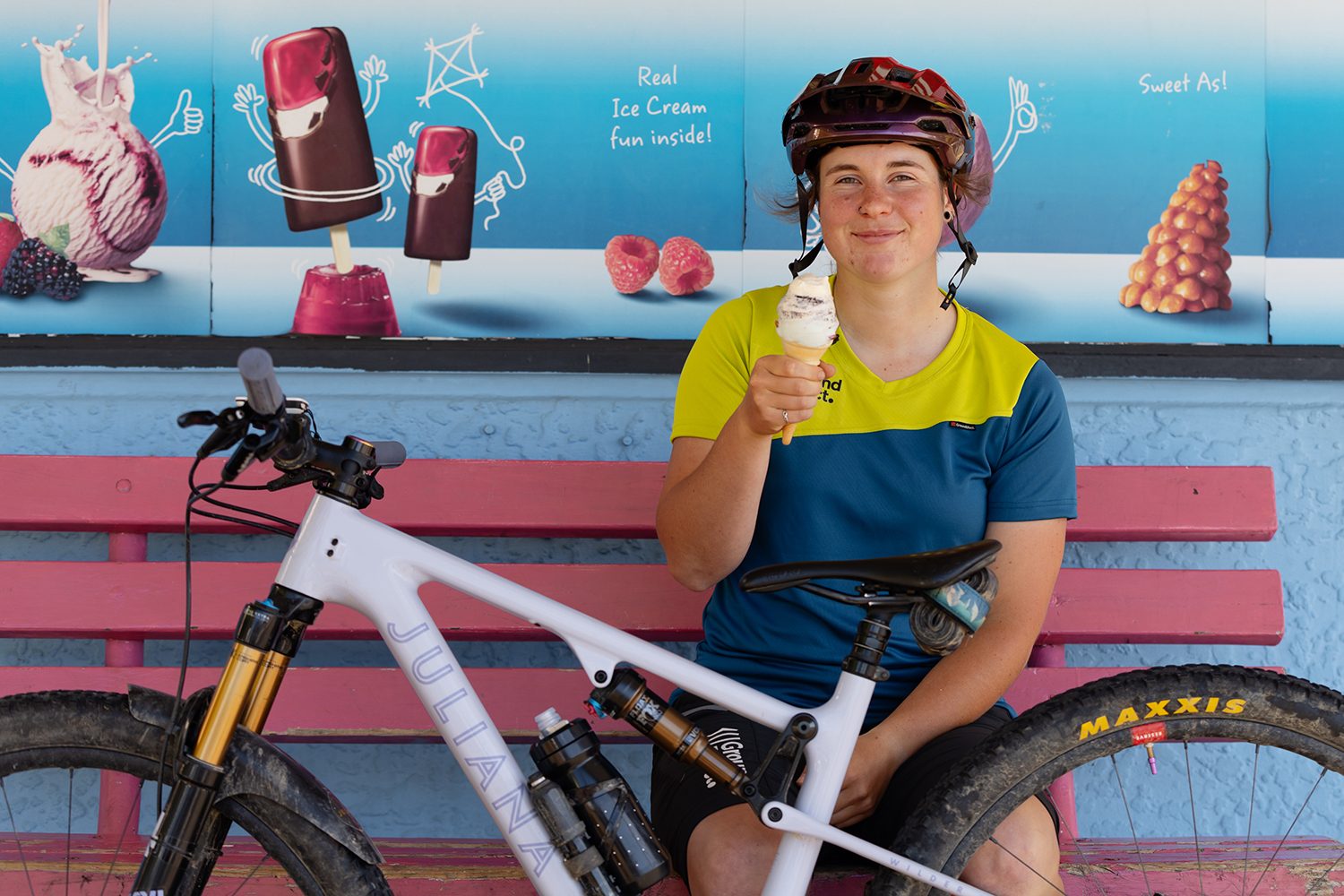Bike Check: The Juliana Wilder, ridden by Emma Bateup
Last time we sat down with Emma Bateup, she was between adventures and training hard for Tour Te Waipounamu (TTW). Since then, Emma has completed the epic South Island ride – in six days and a half days, no less! – and has spent most of the summer riding and going on adventures, all of which she has done on her Juliana Wilder. We sat down with Emma to find out more about the bike itself: how she has it set up; the specs; and the best things about this model.
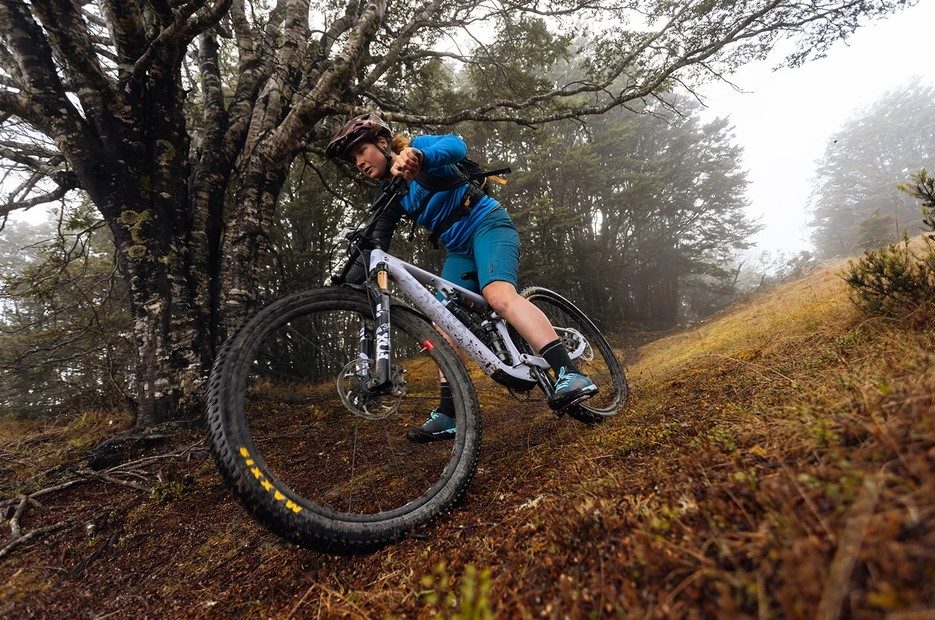
The complete package
Emma’s bike is a Juliana CC Wilder – the highest spec carbon frame available in the Juliana stable. The premier build Emma has includes SRAM’s Eagle X01 AXS wireless 12-speed package, along with a Fox Factory 34 Step Cast Fork and Fox Float Factory rear shock. This package ensures the weight stays low; the original build is 10.88kg.
“The Juliana Wilder is my main bike. It’s a very nice bike – perfect for all the long-distance silly stuff that I do – like my recent completion of Tour Te Waipounamu,” says Emma. “In fact, if there was ever a bike suited to what I do, it’s this one.”
It’s all in the detail
The Wilder features Juliana’s lightest carbon frame and all-new ‘superlight’ suspension design. In building the Wilder, Juliana made lightweight design a priority as well as ensuring the bike is highly efficient in all that it tackles, with every bit of energy translated into forward momentum.
The Wilder’s unique XC-trail attitude is also reflected in the geometry. The head tube angle (67.1 degree) and the 438mm reach on Emma’s medium size frame is a little steeper and a tiny bit shorter than a Joplin, to meet the demands of aggressive climbing. Yet the Wilder’s seat tube angle is a touch slacker, and the chainstays a little longer, than a Joplin in order to retain that familiar Juliana confidence on descents. Speaking of chainstays, each chainstay length is specific to the individual frame size; meaning riders of every height enjoy the same handling and performance no matter what.
Emma finds that the Wilder’s full suspension offers comfort, even on her longest days in the saddle – and there’s good reason for that. It’s been two decades now, and Santa Cruz and Juliana have built their bikes around their tried-and-true Virtual Pivot Point (VPP) suspension. It’s a twin-link, multi-pivot system that connects the rear and front triangles and allows the rear triangle to smooth out the bumps while maintaining pedal efficiency. Their new superlight suspension uses a single pivot design paired with flex stays. In simple terms, the chainstays are directly connected to the front triangle, and flex in the seat stays makes up for the missing linkage. It is meant to provide more traction while the reduced number of moving parts, bearings, and linkage save weight.
SRAM’s Eagle X01 AXS wireless 12-speed groupset takes care of the shifting. The wider range of gearing offers plenty for Emma’s arduous trail rides and multi-day bikepacking adventures. The batteries for AXS do last a long time before they need charging but, for those interested, Emma plans ahead and takes extras when she’s on a multi-day trips into the backcountry. Speaking of backcountry, Emma’s Reserve XC | 28 wheels are designed to be light, but not at the expense of ride quality and durability. These wheels are tough and have gone through many rigorous rides, including TTW, underneath Emma’s Juliana Wilder. They’ve got acceleration-boosting functionality, but are technically confident, and the balance is spot on for most riders. The XC | 28s use Reserve’s latest broader asymmetric rim-bed design to even out spoke tension and provide a 28mm internal width footing for tyres up to 2.5”. The fibre layer is specifically designed to promote vertical mobility.
On top of all that, there is one small (depending how you look at it!) detail Emma is really impressed with, and that’s the fact the frame has not one, not two, but three bottle mounts on it. “You can put two bottles in the frame and one below it. For bikepacking, I put a frame bag in it then a bottle underneath. It means I’m never really short of water.”
The perfect bike
Emma doesn’t do things by halves, so it’s important her bike is up to the task. Thankfully, the Juliana can handle whatever Emma throws at it – and then some. “I really like how capable it is,” explains Emma. “I’ve ridden some pretty gnarly stuff on it – particularly on TTW; there was some decent stuff out there. I passed a few people walking and just smashed on down the hill and thought, well I’m having a great time!”
Since July 2021, Emma has ridden over 6000 kilometres on the Wilder and it’s still in great nick – a testament to the bike and the Juliana brand. The Wilder frameset, along with the wheels and bars, all have a lifetime warranty. This is a great addition as it means the bike can withstand the abuse Emma puts it through, and she can rest assured knowing that these parts can be easily replaced without hassle if there happen to be any issues.
“The Wilder would be ideal for people who are into adventure racing,” says Emma. “I would also recommend it for bikepacking because that’s what I like doing on it. And just anyone wanting a trail bike that goes ridiculously fast up hills! It’s just so easy to ride up hills. I’ve had it loaded up with bags, preparing for TTW, and it’s so light that it still goes faster up hills than my mates on Enduro bikes. It makes you feel like a bit of a weapon riding up hills really! It would also be great for people wanting to do long day backcountry rides like Ghost Road, Heaphy and stuff like that.
The lightness also makes it easier for bike-carrying when bikepacking. There was a lot of bike-carrying on TTW so the fact that it was so light made that really good, even with bags it wasn’t much heavier than carrying my Enduro bike. The electronic wireless shifting on it is really easy to use. You just have to tap it. So, when I’m riding and eating at the same time I can just tap it with my knuckle, and it will change gear. Since TTW I’ve ridden the bike a few times, and my hands were numb for a few weeks, but it was still easy to ride compared to my other bike. I probably shouldn’t be riding when my hands are numb though….”
The only change Emma has made to the Wilder, is a different saddle and the addition of a tool. Everything else has suited her perfectly and she has really appreciated features such as the light weight and the electronic gear shifting.
“I put a different seat on it, just because I needed a slightly wider seat,” explains Emma. “But I only just did that right before TTW, just for the real long k’s, and I definitely found that comfier. I’ve put multi-tool in the steerer because I’m too lazy to carry tools with me otherwise so if it’s already there, I’ll take it. Other than that, it’s just all the same and I haven’t changed anything out. I mean, everything was just so good that you can’t really change it to anything else!
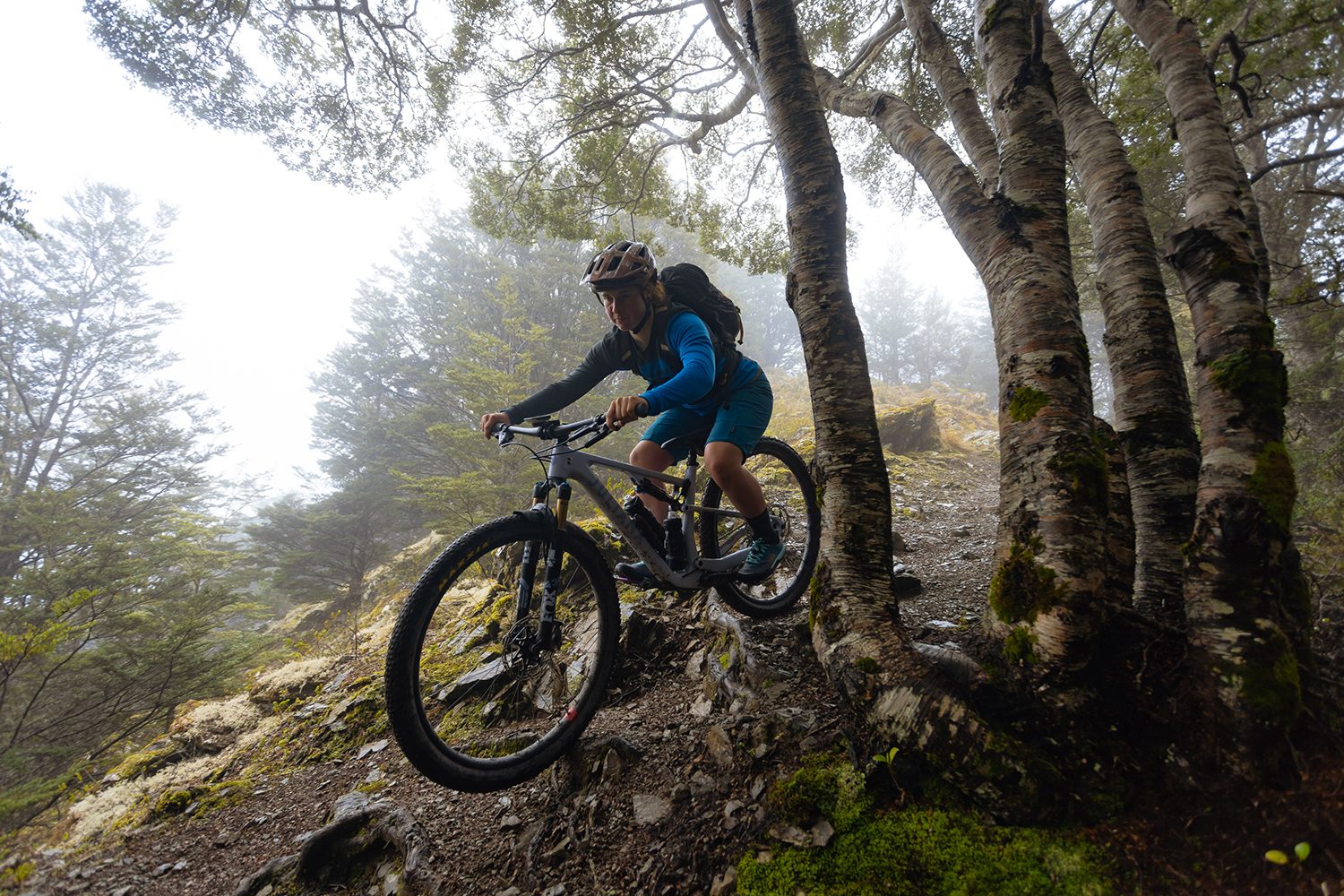
Emma’s ultimate teammate
“It feels a bit like we’re a team!” laughs Emma. “I’ve had it since July 2021 and have travelled over 6500km on it since then. I recorded everything on Strava until just before TTW, and that was at just over 5000, then TTW was 1400 by the time I rode to the start, and I’ve done a little bit more since then – and it’s still in really good nick! I think we’ve taken it apart once or twice since I’ve had it and have just done a good tune up. It’s been pretty amazing to just lube the chain and go for a ride and the bike just keeps going and going.
It performed great on TTW. I had a really good time on all the singletrack we went on – and on anything downhill I just had such a ball. I had to rein it in so I wouldn’t hit a rock and slash a tyre. I’m not really a person who locks out the suspension, but I didn’t lock it out for the ride, not even on the road – the bike pedals really well. We did add a bit more pressure to the suspension, just to compensate for my bags loaded on it. So, it was really good on the road and the only mechanical issue I had was my pedal, which is separate to the bike really anyway! And that was just down to me not choosing the best pedals, longevity wise, so I need to do more research into that. But the bike was mint!”
Let’s take a look at the frame and specs Emma is running:
Frame: Juliana Wilder Medium Carbon CC Frame – Purple Sweetness and Lavender
Fork: FOX 34 Step Cast Factory, 120mm Fork
Shock: FOX Float Factory DPS Shock
Groupset: SRAM X01 Eagle AXS, 12spd, SRAM AXS Controller,
SRAM X1 Eagle Carbon 148 DUB Crank,
SRAM XG1295 Eagle, 12spd, 10-50t Cassette and SRAM X01 Eagle, 12spd Chain
Bottom Bracket: SRAM DUB 68/73mm Threaded BB
Brakes: SRAM Level TLM Brakes, SRAM CLX Centerlock Rotors, 180mm
Headset: Cane Creek 40 IS Integrated Headset
Handlebar: Santa Cruz Bicycles Carbon Flat Bar Syntace LiteForce Stem
Grips. Santa Cruz Grips
Wheels: Reserve 28|XC Carbon 29″ Rims on DT350 Hub Wheelset
Tyres: Maxxis Rekon Race
Dropper Post: RockShox Reverb Stealth 31.6
Saddle: Fabric Scoop
Web: Juliana NZ
Words: Kerrie Morgan
Photography: Henry Jaine
Review: Bontrager XR1 Tyres
“There is something really, really appealing about the instant speed you have on offer from a lighter tyre…”
If there is ever one change I make to my bike, to make it go faster, it’s always my tyres. Whatever discipline you are trying to excel at, tyres are a critical part of making that possible. Tyres are also the one area where you can gain or lose weight dramatically, and the increased impact this has, via the inertia factor, means that if you haven’t thought about changing your tyres to better suit your riding style – you should! Fortunately, they are one of the easiest things to change, which makes experimenting a breeze.
A lot of today’s trail bikes come with pretty chunky tyres, which look great – and give great confidence rolling down the hill – but if you haven’t at least tried a set of lightweight XC tires, you might just not be aware of how much rubbery lard you are dragging around with you. If you predominantly keep the wheels on the ground, and tend to ride in drier conditions, you might be able to try a lighter tyre.
Bontrager’s XR1 are their new, lightest of the light, fastest of the fast race tyres. I’ve been riding the 2.2 TLR (tubeless-ready). The XR1’s weigh in at just 630g, which guarantees speed off the line. The tread is extremely low profile across, with slightly raised outer knobs. It also features the Bontrager ‘TM-Speed’ compound that rolls faster, making it the go-to race tyre for Trek Factory racers. Under the skin, the XR1’s feature a 120tpi construction giving them a nice supple feel and ‘Inner Strength Casing’ which is made of a lightweight nylon insert that provides strong, supple sidewall protection for added tire durability, with minimal weight penalty.
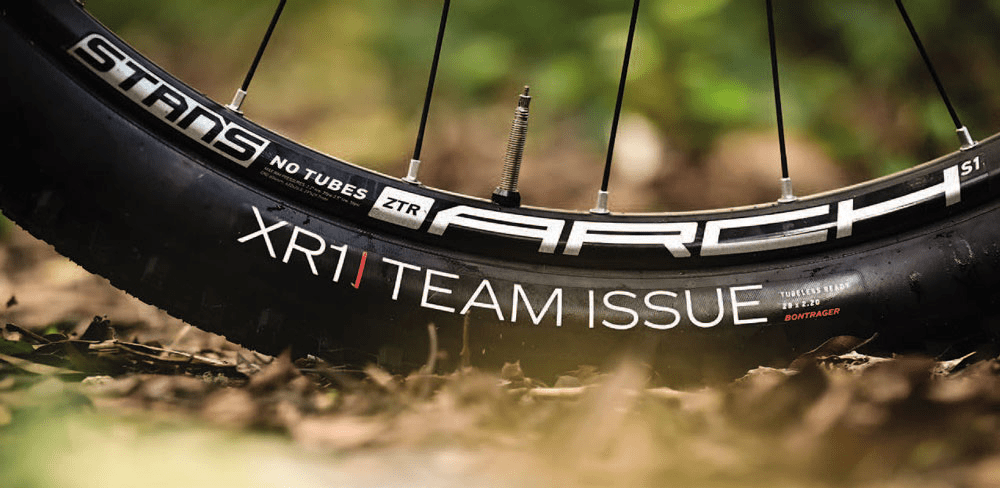
Setting them up on the bike was a breeze. They mounted straight up with minimal fuss and were seated easily with my Blackburn Chamber Tubeless floor pump. Out on the trails, I was again reminded that everything is a trade-off and, as much as I do like riding with larger tyres generally, there is something really, really appealing about the instant speed you have on offer from a lighter tyre – they transform your bike into feeling quite different. The XR1’s really motor along, and the combination of low rolling resistance and low weight means you just seem to be able to ascend in one or two higher gears than you usually would.
The XR1’s are naturally most at home in dry conditions – did I mention those centre knobs are small? They are probably only 2mm tall but, in the dry, they are still surprisingly effective at generating traction. Heavy braking, however, needs to be executed with awareness as it’s not hard to move from slowing down to front wheel drifting – brake on the straight before it’s too late! The TM Speed compound was also impressively grippy over tree roots. In the wet, they have their limitations, and if I knew I was racing in the wet I’d opt for something like the XC2 or XC3. The close knobs don’t shed mud as easily as some others – but, on the plus side, the low knobs don’t hold as much mud either. The side knobs provide surprisingly effective cornering support considering the overall size of their bite. In the dry, I found myself impressed with just how far I could push them. The Inner Strength Casing, so far, has kept the puncture tally at zero – which is great.
Experimenting on tyres isn’t something most of us can afford to do too often but, at an RRP of just $79, the XR1’s fall a decent amount under the cost of some other name brand tyres. So, if you’re looking for a lighter tyre for some summer racing, bikepacking, or even just to make it easier to keep up with your fitter friends, the XR1’s are definitely worth a look.
Review: Lance Pilbrow
Distributor: Trek NZ
RRP: $79
Column: Beer Guide Issue 105
Mountain biking and beer seem to go together, so it’s no surprise to see an increasing number of breweries pedalling beers with an MTB connection.
The first brewery out of the gates with a strong bike theme, was Rotorua’s Croucher Brewing. The brewery was well-established when it did a brand audit five years ago and decided to move away from its old branding – a large C on a stylised shield. That logo shrunk on the label to make room for illustrated scenes from Rotorua’s many adventure sports, with mountain biking and cycling imagery a core part of the new brand.
In the core range, Croucher has the Enduro Pale Ale, Moonride Black IPA and Lowrider, a 2.5 per cent ‘small’ IPA. Seasonal releases include Hard Tail APA, Single Track IPA and Freewheeler West Coast Style IPA.
For founder Paul Croucher, it’s about connecting to the local community and identifying strongly with Rotorua.
“You know how craft beer evolved through hipsters down in Wellington? Well, in Rotorua, it evolved through the adventure sport guys – mountain bikers, white water rafters,” Croucher explains. Croucher goes a step further and is an active sponsor of mountain biking events in the area. And when he says sponsor, it’s more along the lines of supplying beer for competitors to refresh themselves with after they’ve crossed the line.
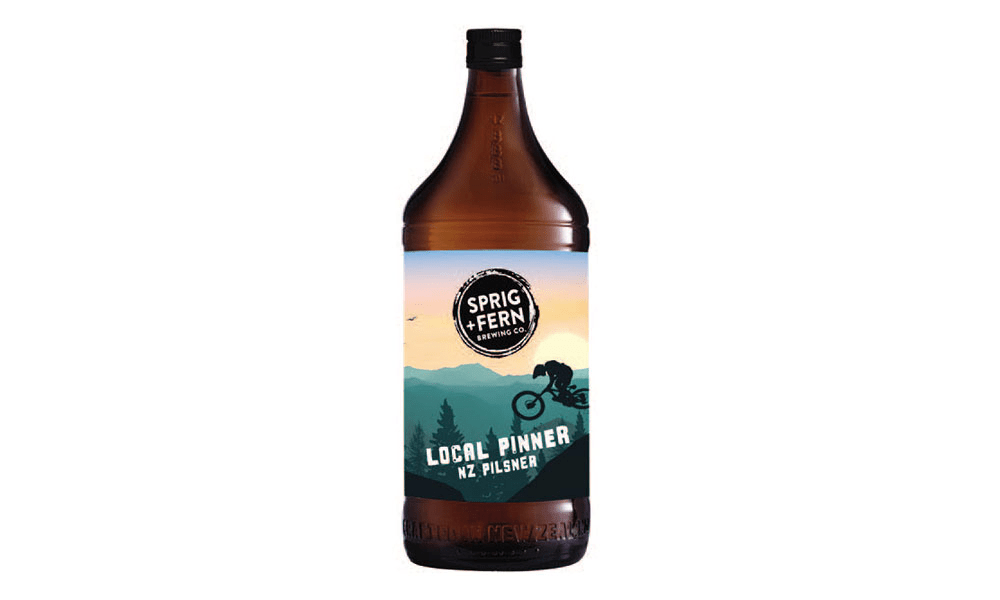
“We sponsor every event we can down here. We’re not exactly a cash-flush business but a lot of events just want a free beer at the finish line. It’s amazing how grateful people are. We just hope to send people away with a fond memory of our beer - and maybe they’ll buy it again.”
Local community plays a big part in many other brands’ MTB connection. In Wellington, Double Vision Brewing were partly drawn to their Miramar location by the mountain bike tracks in the area, says co-founder Warren Drahota.
“We’re all into mountain biking at Double Vision. When we were looking for different sites to set up we scouted a few, including Brewtown in Upper Hutt, but what we found in Miramar was an awesome community — and a whole lot of bike trails a couple of blocks away.”
The Miramar Track Project takes in the area around the old Mount Crawford prison on the end of the peninsula, with track names such as Repeat Offender, Jail Break and Solitary.
Before they’d even opened the brewery, Double Vision had a beer called Repeat Offender, which featured a rear view of a mountain biker jumping over a police car. But when Drahota did a bit more research he found Mount Crawford used to be mixed gender prison so they reworked their artwork to have a woman on the can.
Bringing a woman onto the beer was an important connection for American-born Drahota, who grew up idolising his cousin Karen Tremaine, who was one of the best riders in the US at the start of the century, contesting World Cup events.
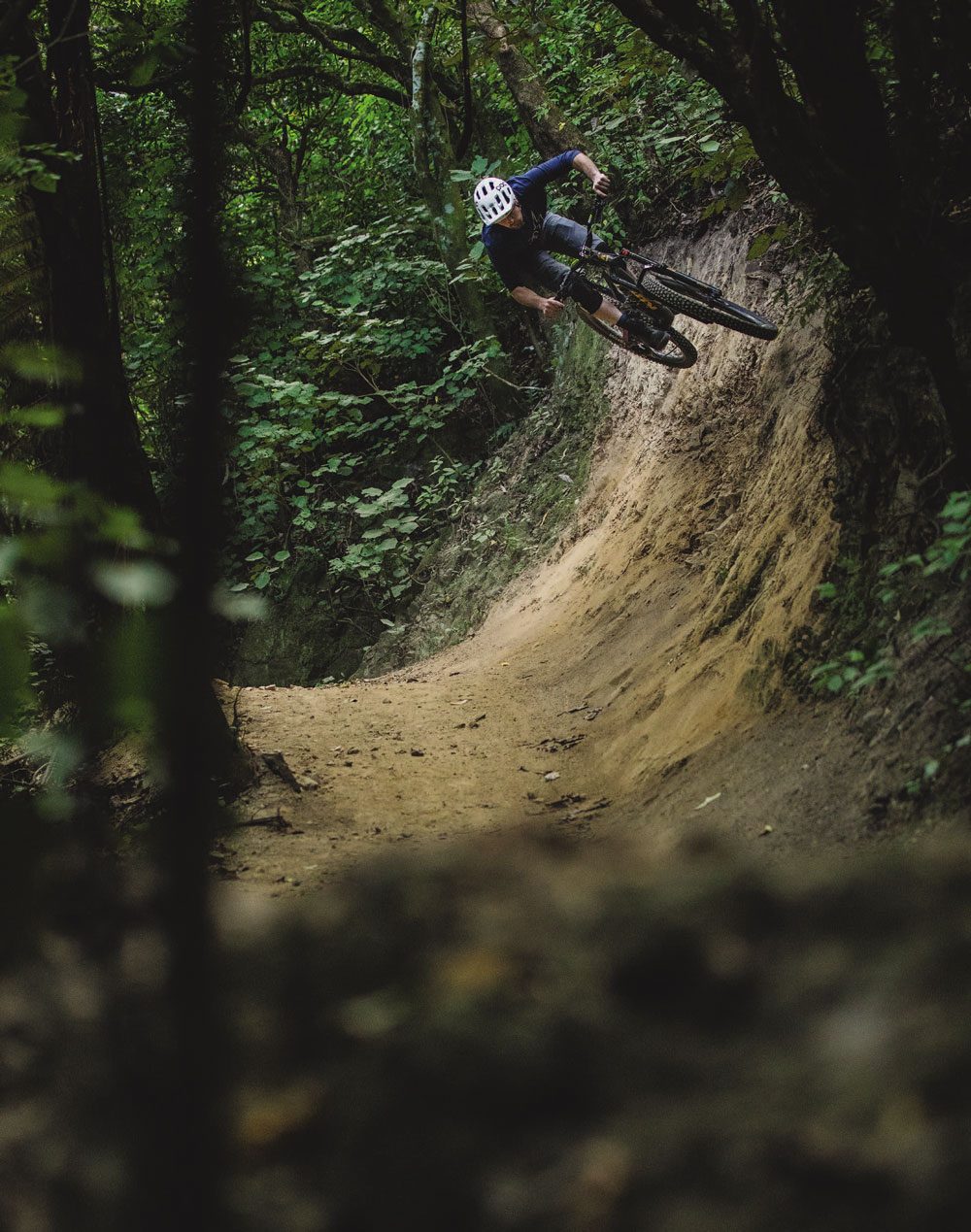
There’s also a strong female presence on the Miramar tracks.
“We have heaps of riders in Miramar but the amount of phenomenal female riders is high compared to other places I’ve been mountain biking.”
There’s a similar story behind Eddyline’s Crank Yanker IPA, albeit with twisty history. It started life — as Eddyline did — in New Mexico, where Mic and Molley Heynekamp opened their first brewery. They had an IPA based on one of their home brews and named it Pick Axe IPA, as a tribute to the nearby New Mexico Institute of Mining and Technology. When they moved Eddyline to Colorado, they realised Pick Axe wasn’t going to work in the adventure state so had a competition to rename the beer.
“We had a ton of mountain biking that started right near the brewery,” Mic Heynekamp explains. “And someone came up with the name Crank Yanker, explaining that the beer was what you had after you ‘yank your cranks all afternoon’. It’s apt because the brewery is at the bottom of the valley and every climb starts with a brutal ride up.”
When they moved Eddyline to Nelson, Crank Yanker came too and Heynekamp said the name translated well.
“Most people that mountain bike get it. But the funny thing is that we did have some locals going ‘cranky Yankee’.”
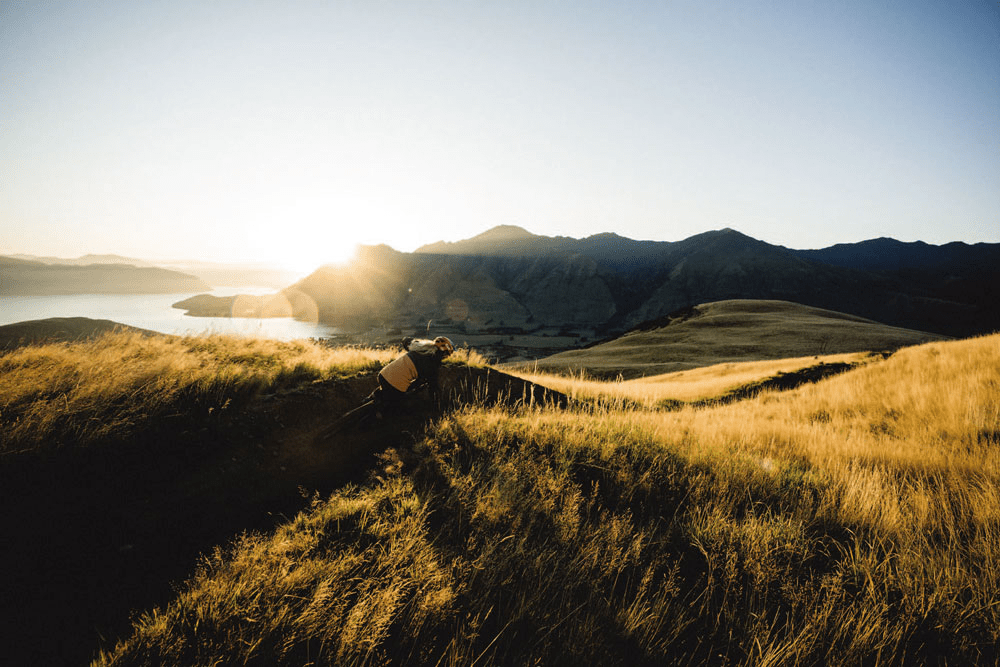
The label comes from an oil painting done by then rising artist, Jesse Crock.
In something of a bonus for Eddyline, shortly after they opened in Richmond, the Silvan Forest Mountain Bike Park opened in the hills above the brewery.
“A lot of people park at our place, ride up and come back down and have some pints; beer and mountain biking goes together great.”
Nelson’s strong MTB culture is reflected in Sprig + Fern’s Local Pinner Pilsner.
Local Pinner is slang for a fast and experienced racer. The idea for Local Pinner came from Sprig + Fern designer, Hayley Ottman, who hails from the West Coast of America and loves to ride. She designed the label after a ride with friends, capturing the adrenaline of Nelson’s world class mountain biking culture and giving a nod to enduro and downhill racers.
“I’m into all outdoor sports, specifically growing up with surfing. Locally, my brother also used to race downhill mountain biking and is the one who brought the likes of Loose Riders to Nelson, so biking is in my blood,” Ottman explains. “Even if you don’t bike, it’s showcasing that this sport and its culture is bad ass and this is a bad ass beer.”
In the deep south, Wanaka’s b.effect has gone from supplying beer to Bike Glendhu, making a beer specifically for them, to now partnering in a tree-planting project. b.effect founder, James Hay, is a keen mountain biker and was working with Bike Glendhu, sponsoring events and giving them beer when they needed it. Eventually, the two businesses came up with the idea of brewing a beer specifically for Bike Glendhu.
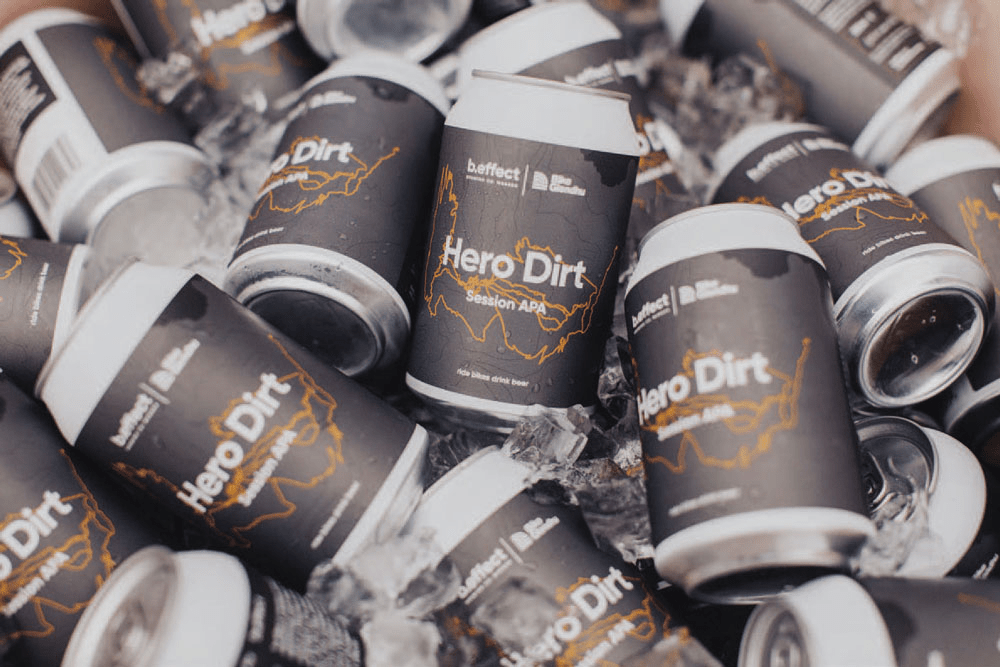
The result is Hero Dirt, a sessionable 4.6 percent American Pale Ale, designed to be enjoyed after a ride.
“Bike Glendhu is about 15 minutes out of town, and the beer was originally made for their café; we wanted people to be able to have one or two and still get home OK,” explains b.effect marketing manager, Molly Hope.
The two businesses aligned further around carbon-offsetting.
“About six months ago, we started on a sustainability journey, doing a carbon footprint audit to work out where we were, and to make steps to reduce emissions.
We want to use our beers as a force for good and we want the consumer to understand where it’s going and have a relationship with the beer. Bike Glendhu had an initiative to plant 30,000 trees by 2025 and we already wanted to plant trees, so we decided on 3 percent of sales to go back to them.”
Hope said they were asking local stockists to match their donations; “to make it a community effort and tell the story that this beer you’re drinking helps plant trees”.
Words: Michael Donaldson
Photography: Caleb Smith and Callum Wood
Review: Camelbak Rogue Light
“The Rogue feels like it’s barely there.”
The Rogue Light is Camelbak’s latest lightweight hydration system. With its minimalist setup, the Rogue is ideal for when you need to take a bit more than a bottle, but still want to take as little as you can get away with.
The Rogue comes supplied with a two litre bladder, which is just right for a decent ride. For storage, there is the main compartment that the bladder sits in – this has a small internal zippered pocket, great for glasses or wallets – then there is another zippered pocket on the side, which is ideal for keys, muesli bars and multitools. Lastly, there is an open pocket which is ideal for storing a raincoat, and having it open means you can whip it out quickly when a shower comes through. It’s available in no less than five colours; on test is the Fired Brick / Koi version.
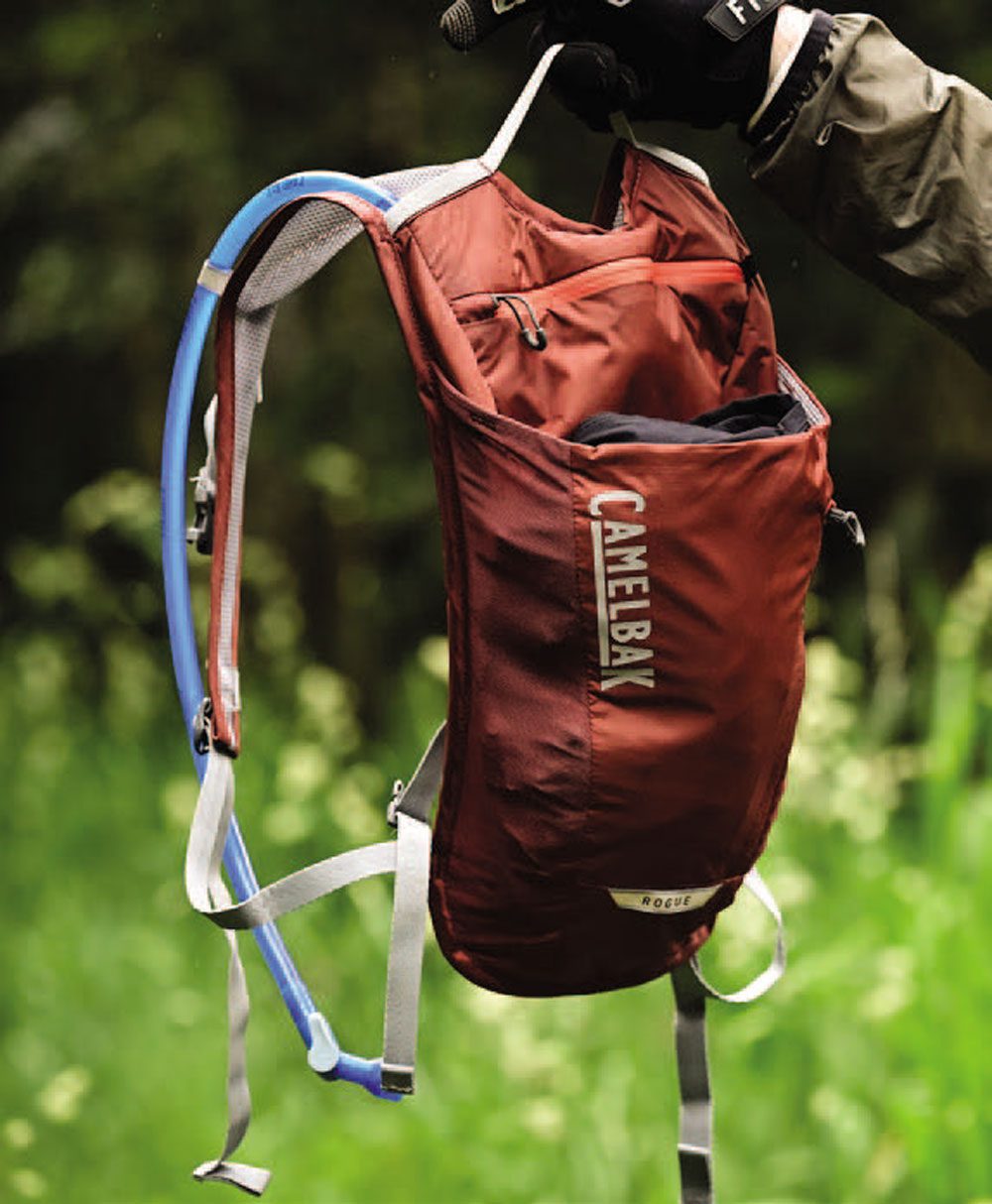
The fabric of the Rogue is noticeably thinner than previous Camelbak’s I have owned, and this obviously helps keep the weight down; being lightweight and breathable is clearly the defining goal. The shoulder straps are a mesh material, as are the side panels of the pocket, while the back panel is Camelbak’s Air Support system which, again, creates a sort of lightweight, padded mesh panel on either side of your spine, creating a groove for your spine to comfortably sit in. On the front, there is only a single strap across your sternum. I thought I might miss having a hip strap, but on a lighter bag like this I didn’t notice its absence one bit. The Rogue stayed in place just fine and I never noticed it rocking around, side to side. Internally, the bladder sits neatly in its pocket and is held in place vertically by a hook and loop system, with the plastic loop of the bladder hooking into the sewn loop of the bag.
Camelbak’s Bite Valve system is tried and true, I find the flow just right and really like having the shut-off valve that prevents anything leaking out when something is sitting on it in the boot of the car.
I’ve had a number of Camelbaks over the years, and they’ve always been larger versions, such as the M.U.L.E. However, I can see real appeal in these lighter versions.
Often, a larger bag on your back feels heavy and sweaty on hot days – comparatively, the Rogue feels like it’s barely there. Because of that, there are a number of people that the Rogue might really appeal to – for starters, younger riders. The Rogue is fundamentally just a small, light hydration pack. With a lot of smaller kid’s bikes not having room for a water bottle in the front triangle, having a backpack is ideal – but most packs are adult sized.
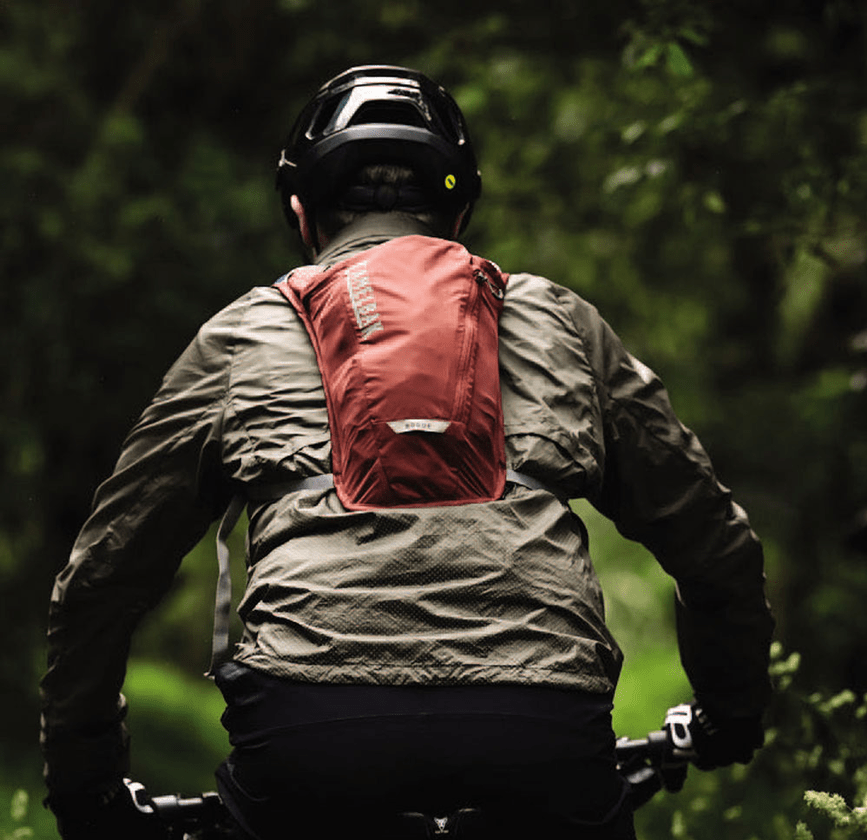
The Rogue is small enough that it actually looks just right on kids. Our kids (aged eight and ten) can attest that the Rogue is a winner for them. (There is a heap of adjustability in the shoulder straps so don’t think that it’s not a good fit adult’s too!)
The second unique group that might be really interested in the Rogue, are the bikepackers – or ultra-distance riders – who, again, want minimal equipment but often need to carry extra water through a section, or the ability to stow more food than their bags can easily hold.
The Rogue fits the bill nicely for them too and, as a bikepacker myself, I think I will be taking this on my next mission for this very reason.
I really liked the Rogue Light. It’s minimal, durable, cool, and comfortable.
At first, I thought this probably wasn’t a product I would have bought for myself, but after having a chance to test it, it’s actually got a lot of use – I probably grab it more often than I do my M.U.L.E now, and the fact that it makes a great fit for the kids as well means that it’s getting used by someone on just about every ride. •
Review: Lance Pilbrow
Distributor: Southern Approach
RRP: $139
Review: Bontrager XXX Shoes
“Not only do these shoes ‘feel’ fast – in the sense that you can indeed feel them not flexing – they also give you a very secure and connected feel on your pedals.”
When it comes to XC riding and racing, it’s all about getting the power transferred from your legs, through your feet, and into the pedals. But – there’s a critical link in that chain that can make a massive difference: shoes.
Having a stiff shoe that won’t flex under the massive power that you’ll be generating as you sprint off the line, is vital to achieving good results. But there’s more to it than just a stiff platform – the whole shoe needs to be comfortable too, so getting the form and shape of the shoe ‘last’ is essential when creating footwear around the additional goals of being both lightweight and flex-free.
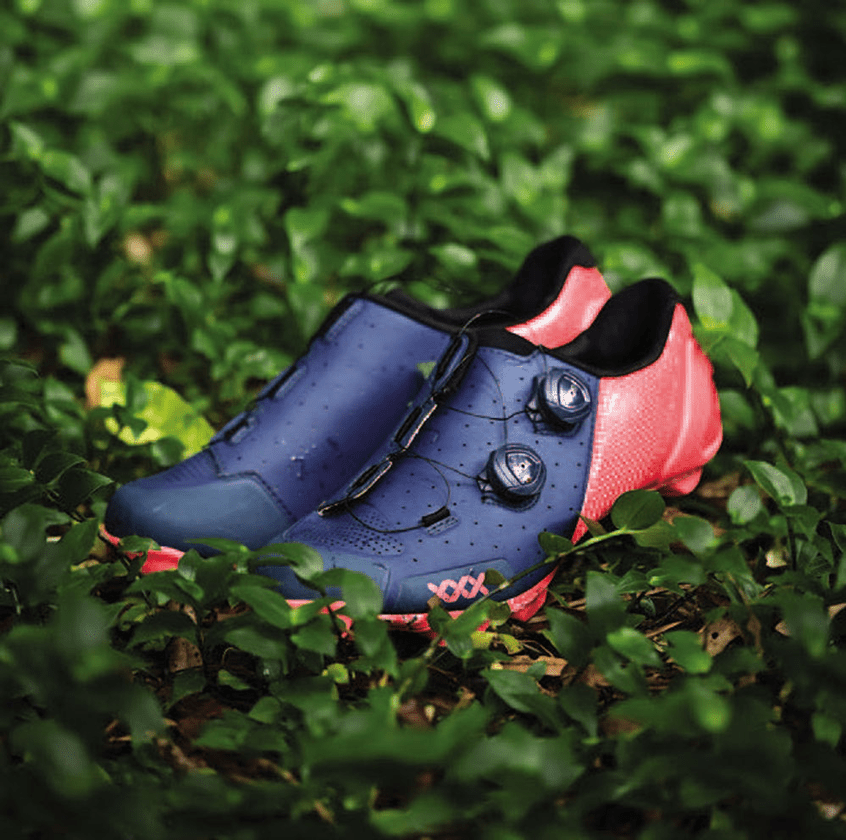
The XXX shoes are Bontrager’s top-of-the-line XC race shoes. And kind of like their name suggests, they are a bit racey. The XXX’s key features include a 100% OCLV carbon sole – that is extremely lightweight and stiff for efficient power transfer; dual independent BOA dials for precise, zone- specific fit adjustments; and their ‘inForm Pro’ last that delivers an ergonomically optimized and high-performance fit.
Out of the box, the Nautical Navy/ Radioactive Pink version that we tested was, well, eye-catching, to say the least – perhaps a little too much so for some, but they are also available in a plain black on black. Slipping them on and dialing up the Boa retention system, they felt just right in terms of sizing, and the Boa system gave a nice even tension across the top of my foot. I run a size 44 shoe normally, and these felt true to that. I would say I have a wider than normal foot and, somewhat surprisingly, these still felt spot on.
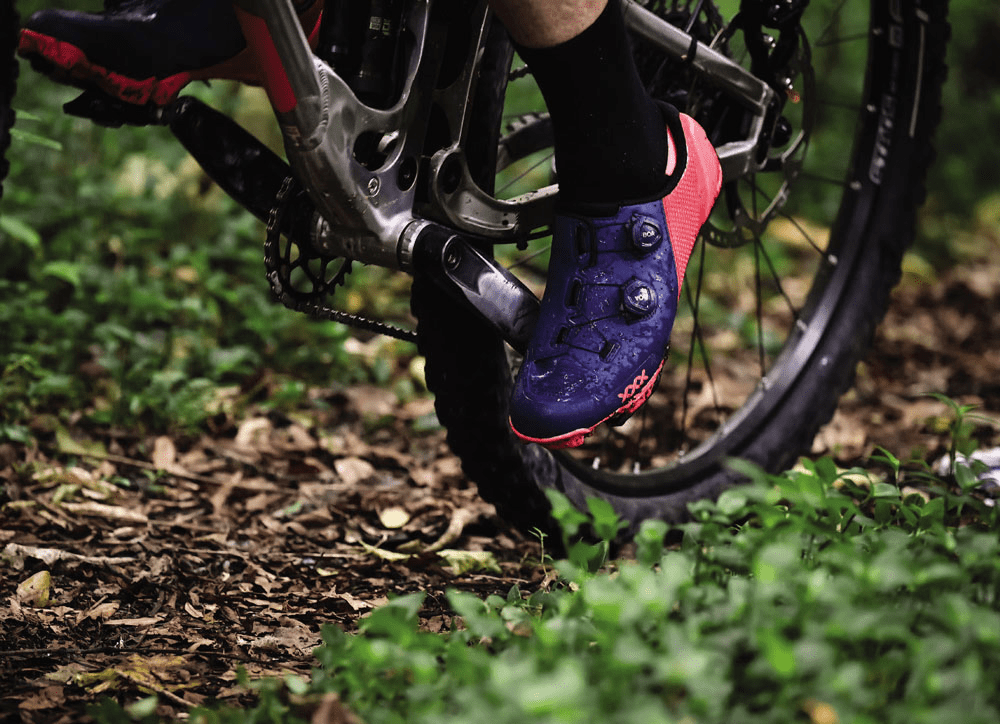
Walking around, it was clear that these shoes are meant to do business; they are extremely stiff. Bontrager rate their shoe’s stiffness on a scale of 1 to 14 and, as you might have guessed, these are a 14. Having never owned or tested an XC race shoe of this calibre, I was really impressed with how they felt to ride. Not only do they ‘feel’ fast – in the sense that you can indeed feel them not flexing – they also give you a very secure and connected feel on your pedals. On the bike, I was really impressed by just how comfortable they were.
My expectation of a shoe like this was that they would be light and stiff at all costs – maybe even at the expense of some comfort – but that wasn’t the case at all. They have ample padding in all the right places.
At the same time, there isn’t padding where you don’t need it and the shoe uppers themselves feel thinner than other more casually oriented shoes; I found this makes them breathe well, as well as dry out rapidly.
After a few rides, I had an opportunity to really put them through their paces on the Old Ghost Road. Surely 86km would be a real test for these! By the end of the day, I truly had put them through their paces, and did find just one or two areas worth noting. The underside of the shoe has a very thin layer of what I assume to be paint, on the carbon sole. After the numerous times we had to get off and walk on the OGR, as well as descending the significant rock staircase of the Skyline Steps, the paint on the sole was fairly trashed. Not only that, walking down the rock stairs I became aware that these really are indeed not walking shoes. The centre area under your arch, on the outer sole, is the aforementioned painted carbon and this offers very little grip. There is a little patch of rubber in this area, but walking down the rock staircase with my bike on my shoulders, over uneven ground – often standing on this carbon patch – the underneath of my arch felt fairly treacherous. Also, the rubber Tachyon tread on the front half of the sole is OK but, if I could have my way, it would be a softer, grippier compound to give you some more confidence in these situations. Obviously, these shoes are meant for XC racing which, generally, doesn’t involve a lot of hike-a-bike, so to be fair I was probably using them outside their intended use. But the reality is, a lot of consumers will use these for much more than just racing. Speaking of rocks, what I was happy about was the GnarGuard coating that surrounds the toe box, after the OGR and a number of other rocky rides, the toe box still looks in great nick – so, even though the soles are well scratched, for the most part you don’t see that and the uppers look great. Our ride was 10+ hours and at about the nine hour point I started to get some pain in the centre of my foot but, again, that was probably due to using these beyond their intended use. The inner soles are quite thin, so better insoles with a little more support is something I would look into for the longer term. On the whole, I was really impressed with their comfort over the whole day.
At $599 the XXX’s are a premium price, but they are also – undoubtedly – a premium shoe that will be appealing to a lot of riders looking for a stiff, light, fast shoe to tear up the race track this summer. •
Review: Lance Pilbrow
Distributor: Trek NZ
RRP:$599
Feature: The Boomer 'E'volution
While Gen X, Millennials, and Gen Z have long been purveyors of mountain biking (in fact, we know many who could ride before they could walk!) there’s a whole other generation of cyclists currently getting a new lease of life on your local trails. The new kids on the block are not actually kids at all, though. They’re the Baby Boomer generation – aged between 57 and 75 this year, and affectionately known just as ‘Boomers’ – complete with slick eMTBs and all the kit. If you haven’t seen them out on the trails (often riding in a large pack) you’re sure to catch a glimpse of them racing through the trees soon enough.
Two such Boomers are Tim and Pat Felton, although they prefer not to be called that. Full disclaimer here: Tim and Pat are my parents, so if my tone sounds a little endearing, it’s because it’s supposed to. The Felton’s are no strangers to mountain biking – Tim first bought mountain bikes for the family in the late 90’s, in the hopes we would all ride together out in the patch of forest now known as Woodhill Mountain Bike Park. Initial outings were somewhat disastrous (rugged tracks, ankle deep sand and massive tree roots come to mind) but some years later, when they became ‘empty nesters’, Tim and Pat bought new mountain bikes to take with them on campervan trips around New Zealand. During this time, they completed the Otago Rail Trail and the Twin Coast Cycle Trail to name a few great rides. Those mountain bikes (generic hardtails that did the job but were nothing special) were passed around the entire family, and then some. They’ve only just been handed over to new owners some 10+ years after Tim and Pat bought them. But room had to be made in the garage because [cue suspenseful music] the eMTBs have landed!
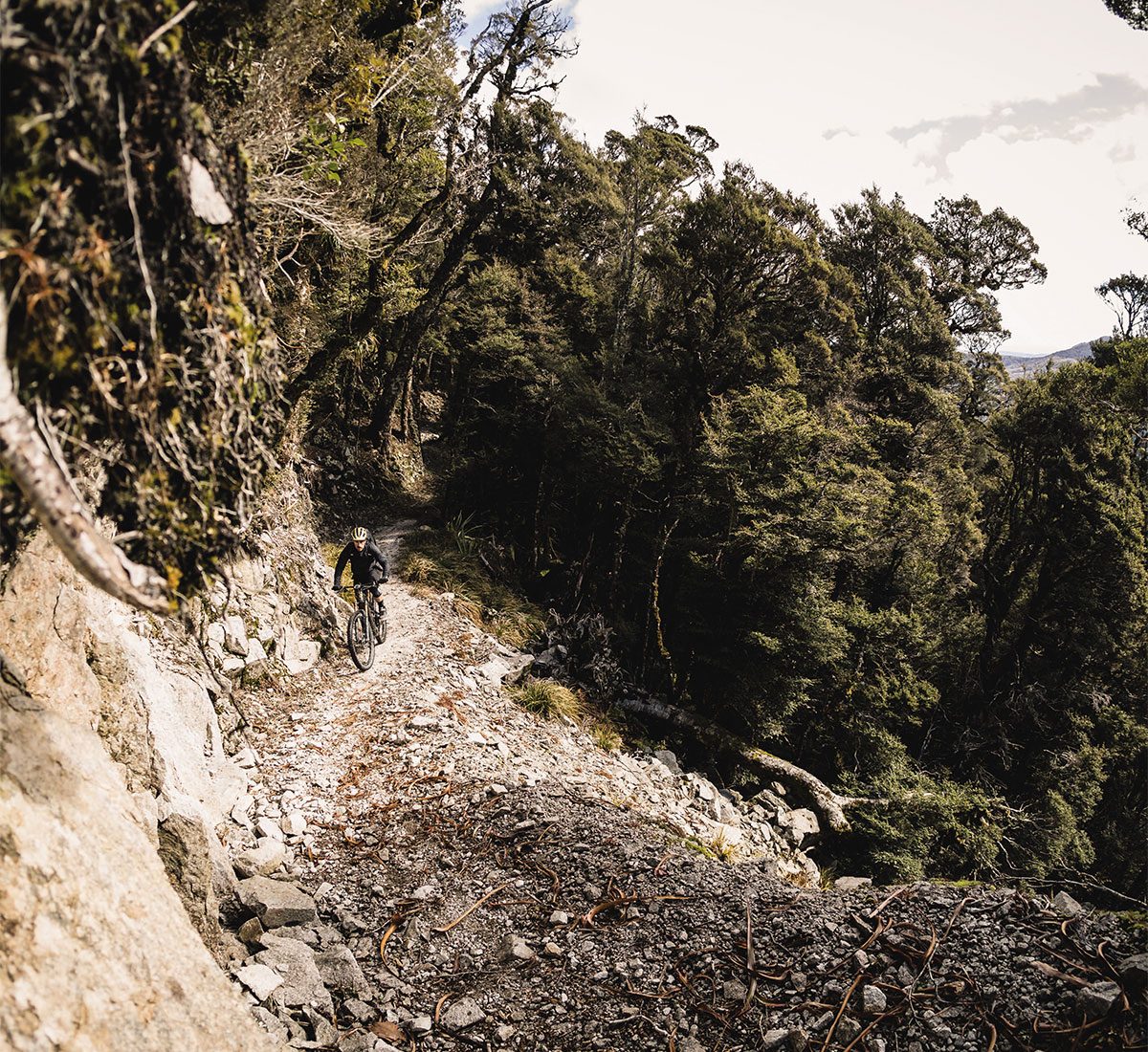
“On eMTBs we can explore places we’ve never been before – without having to worry too much about getting exhausted or riding too far and not being able to get back easily,” explains Tim. “Carrying supplies in a panier or pack is also easier and the added weight isn’t noticed, thanks to the power of the bike.”
Make that ‘thanks to the power of Bosch’, too. Bosch- powered eMTBs are partly responsible for this recent ‘boom’ in older, first-time mountain bikers, thanks to their modern technology, slick design and raft of features suitable for both beginner mountain bikers and those who are more advanced. Long battery range offers peace of mind when Tim, Pat and their friends head out on the trails for the day, while different ‘modes’ offer increased power meaning that it’s not just the downhills which are fun but the uphills and long straights as well. Even stretches of road – previously making for sluggish work on a traditional MTB – have become easy and enjoyable to tackle.
There’s a good reason bikes are in short supply countrywide. The ongoing pandemic and repetitive lockdowns have seen an increased number of sales, with the Baby Boomer generation keen to spend their money on high-end eMTBs and gear and get out on the trails as quickly as possible.
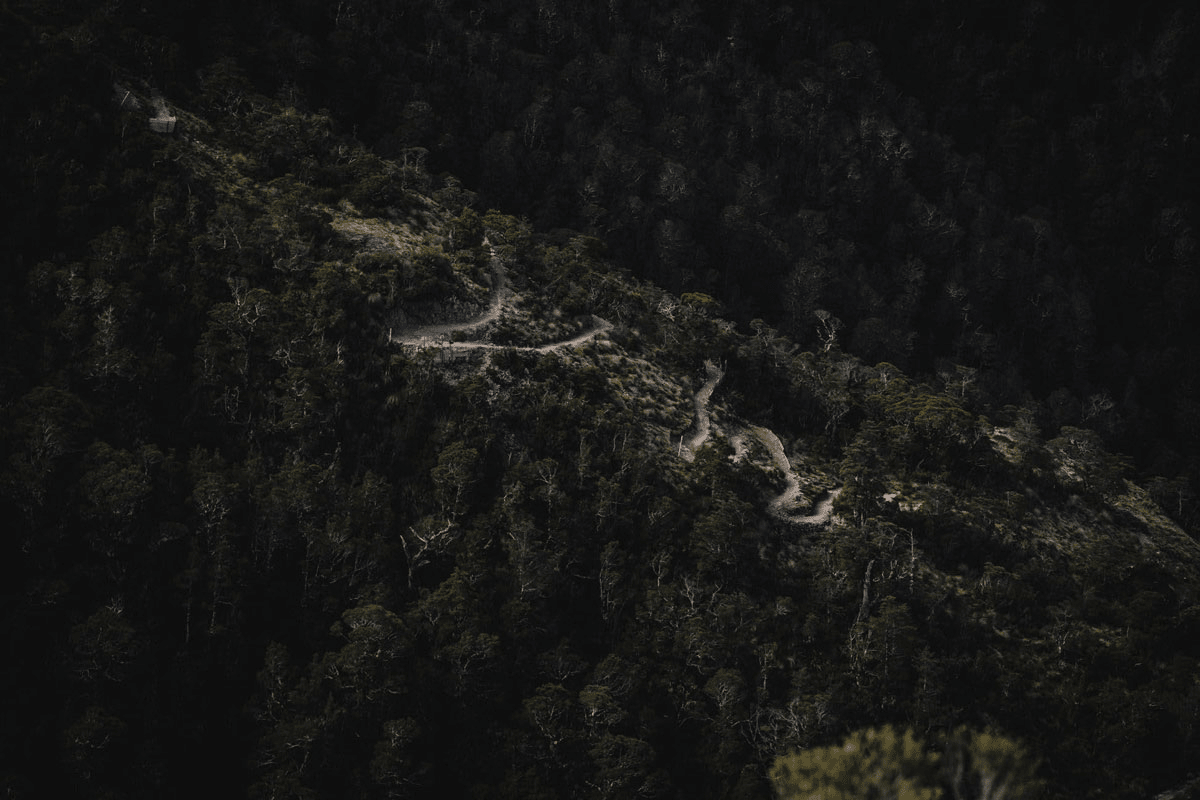
“We were already doing a lot of walking during lockdown, but getting the eMTBs enabled us to explore our own neighbourhood even more,” says Pat. “It turns out there are some great trails really local to us, including Shakespeare Park on the Whangaparaoa Peninsula, and Sanders Reserve in Paremoremo, which have been fun to practise on.”
And practise has been key. Although no strangers to cycling, riding eMTBs is a different game altogether and has taken some getting used to. “We were used to riding on the road – and even some light off- roading – as we’ve done that for years, but now we’re trying to build up our skills and confidence on slightly steeper, harder trails,” explains Tim.
Riding eMTBs is not just about learning something new and getting fitter, it has also opened up a whole world of possibility with regard to trips away within New Zealand. With the rest of the Felton family still based in the UK, regular trips across the globe were normal for Tim and Pat, during the pre-pandemic years, as it was their only means of catching up with their siblings and lifelong friends. Now, with the pandemic still raging, they’ve had to change their perspective on travel and pivot towards New Zealand based adventures – something that’s not hard to do when you’re armed with an eMTB and a luxury specific to Baby Boomers: time.
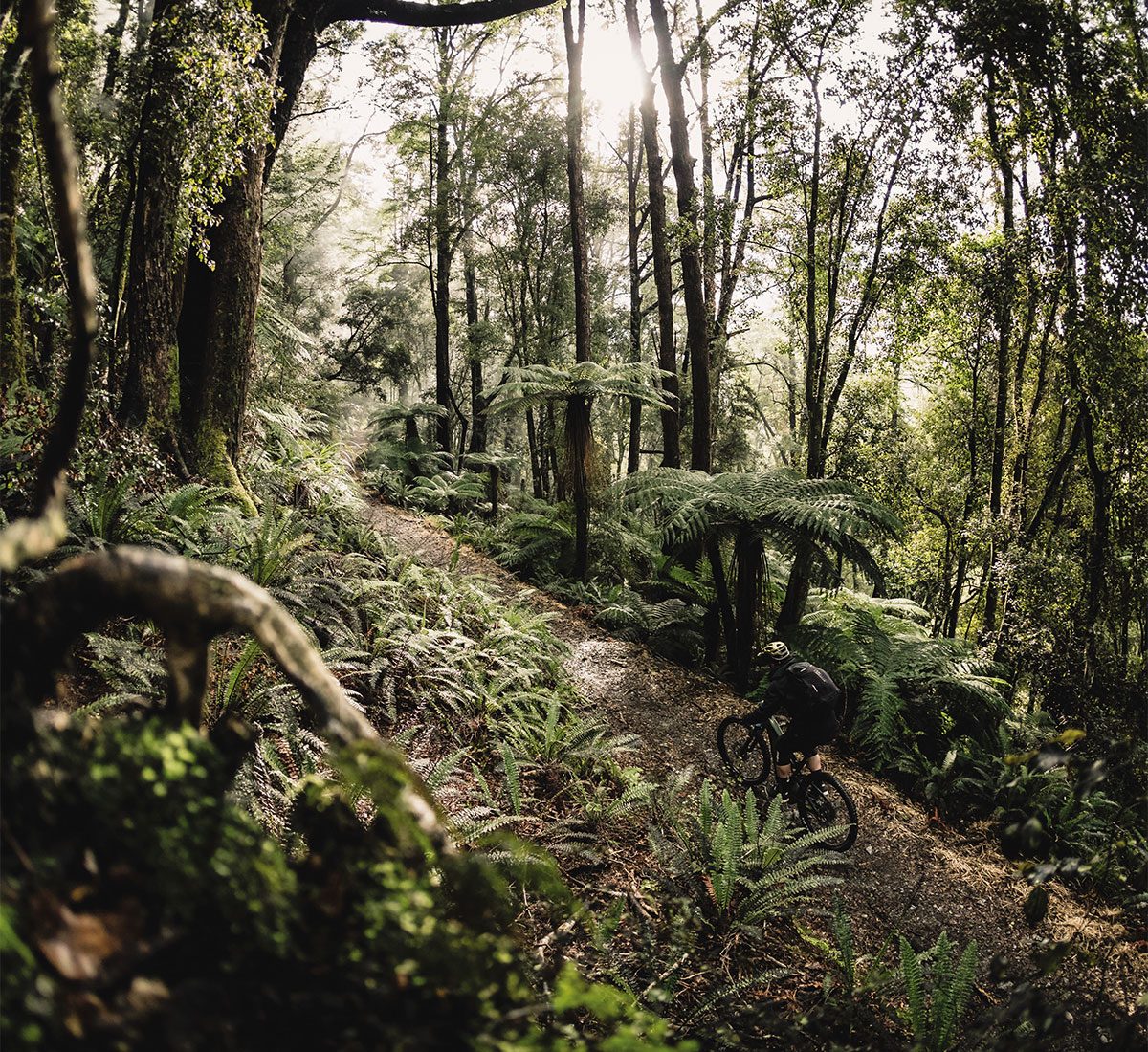
What this also means, is that Tim and Pat are rarely alone on their eMTBing adventures. The age and stage they are at in life means there is a slew of others in the same boat who are keen to join them.... and there’s no dawdling! In fact, seeing them all out together in a big crew you’d be mistaken for thinking they were a squad of riders half their age.
“As a group, we’ve done some of the great New Zealand rides over the years,” says Tim. “But now, with the eMTBs, it’s about pushing the limits a bit and going on some real adventures. We’re keen to head out into the wilderness a bit more and these bikes give us the opportunity to do that – without having to worry too much about fatigue or burning out on long trails.”
The Boomer ‘E’volution proves it’s never too late to hop on a bike and hit the trails or plan a multi-day bikepacking trip with a group of likeminded friends. There has to be some silver linings to this pandemic, and new people joining our mountain biking community – regardless of age, stage, skill-level or the bike they are riding – is definitely one of them. •
Words: Kerrie Morgan
Photography: Cameron Mackenzie
Feature: Otherworldly Adventures Mountain biking in Iran
For the past year – almost to the day – I have called Tehran, the capital of the Islamic Republic of Iran, home. After arriving from New Zealand directly into Tehran’s Imam Khomeini International Airport, in November 2020, it became immediately clear there were many major contrasts between this country and my homeland, New Zealand. The picture painted of this country, in the western mainstream media, will be known to many of those reading this. Before going any further, I should quickly explain why I am currently based in Iran: my wife is a New Zealand diplomat and has been posted from Wellington to work at the New Zealand Embassy, in Tehran, for three years. After the initial adjustments to life, in the first six months, the remainder of our first year has sailed by.
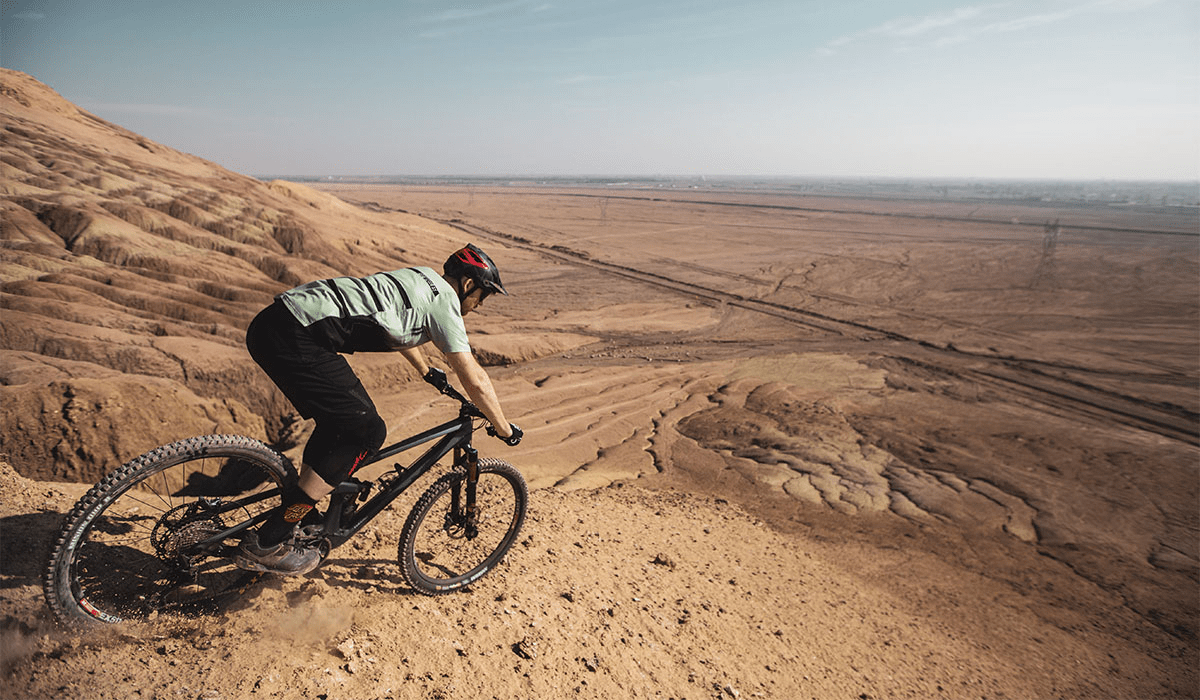
Prior to our departure from New Zealand, I was determined to keep an open mind so as to experience this place as fully as possible. The sum of the geographic, cultural, political and social differences in comparison to New Zealand constantly raise a novel feeling. It appears that any sense of knowing or gleaning somewhat of an understanding, will only be gained by spending significantly more time here. A combination of experiencing the situation on the ground, and discussions with the locals, reveal – very slowly – bit by bit of this unique place. Somehow, I’m not sure any foreigner ever comes to fully understand this complex and unreal country regardless of one’s ability to speak the language, or the length of time spent here.
Scouting the Trailforks app prior to my arrival in Iran, I could see there were a couple of trails on the fringes of the capital city, which is home to almost nine million people. There appeared to be a bit of a racing scene too and, after finding a few die-hard riders’ Instagram accounts, I could see their level of commitment to the sport was high. In any case, it wasn’t easy to find much media showcasing the riding, unlike what you might find spread across the internet for places such as New Zealand. Indeed, it was hard to gain any major insights into the extent of the sport, especially with regard to the trails, before arriving. I did, however, discover that the capital city was surrounded by very tall mountains and, equipped with this knowledge, my hopes of finding some decent riding were high.
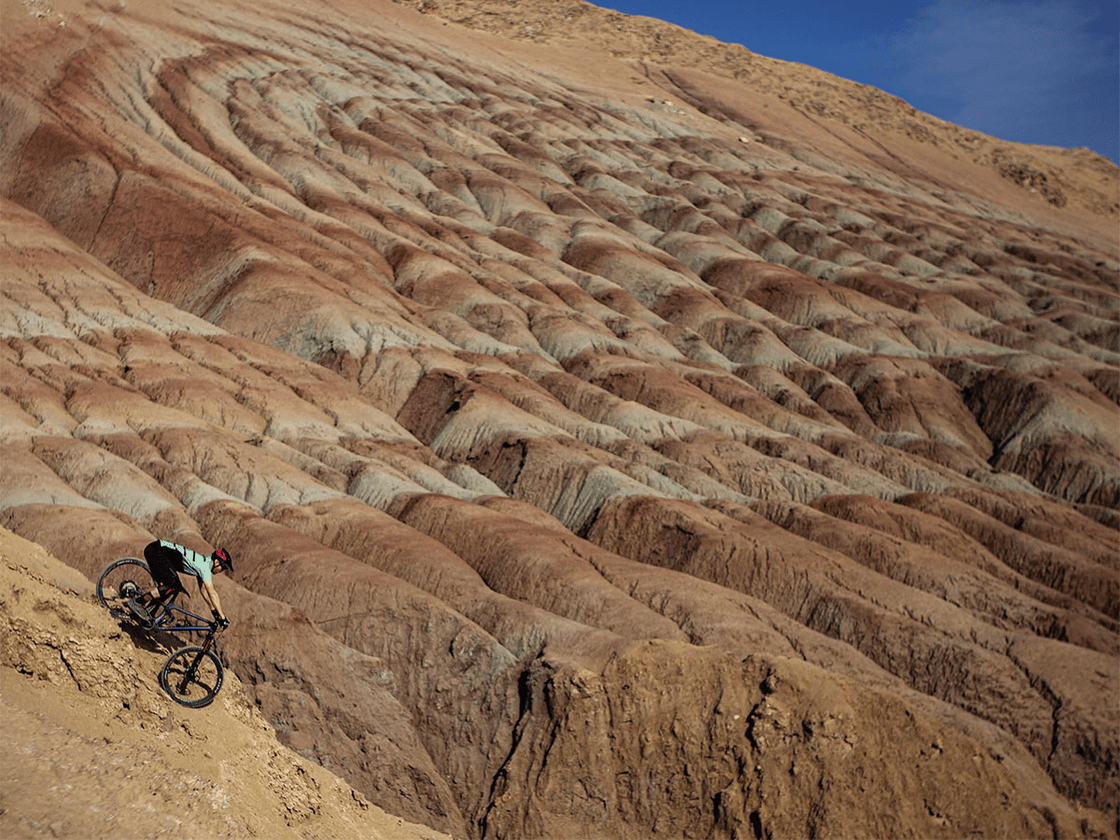
The Alborz mountain range, spanning the vast width of Northern Iran and dividing the Caspian Sea in the north and the Iranian Plateau to the south, is where most of the mountain biking takes place. There is no shortage of terrain in this mountain range, with its highest peak at 5,600m. The scale of this range blocks any humid air from the Caspian Sea and divides the north facing mountains and lush forests of the far north from the rest of the country, which consists of heavily eroded mountains, arid landscapes, and desert like features.
There are two main types of riding around Tehran, the first consisting of a minimal amount of mellow single- track riding on the foothills of the main range; and the second being the burlier trails stretching high up into the Alborz mountains. The types of trails that stretch up into the main mountain range are typically hiking trails. Since mountain hiking and climbing are such popular weekend activities for Iranians, in all seasons, these trails can be found in many towns and villages throughout the Alborz. For me, the best riding around Tehran takes place primarily on hiking trails. These trails tend to be the cleanest to ride at the end of summer, when the snow has well and truly disappeared and the regular passing feet of hikers have cleaned the riding surface. Although, due to a combination of the rocky terrain, hot dry summers and freezing winters, the surface is constantly shifting on top of the dense bedrock below.
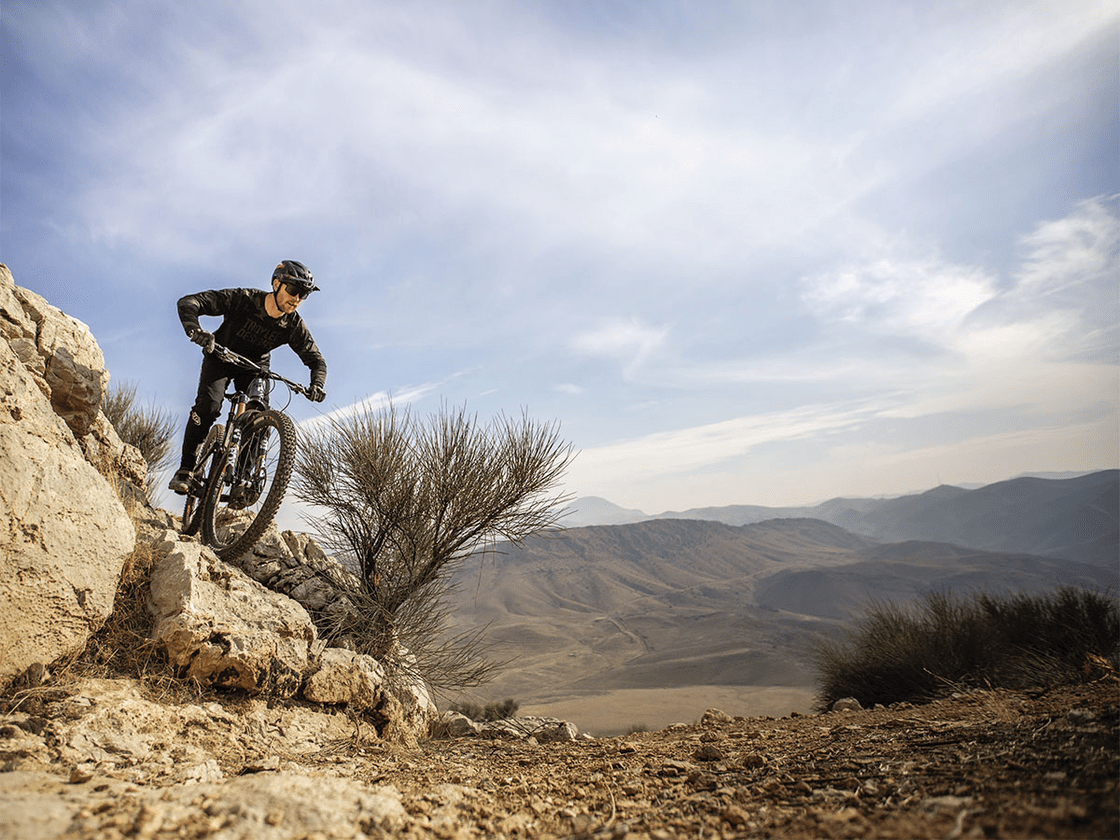
The trails I frequent for the usual mid-week laps are ones that have access roads to climb the steep mountainous terrain, but it’s still hard work even with the 51-11 cassette. This area, known as Darabad Mountain, is also frequented by downhill riders at the weekends and a few local riders living in the neighbourhood, during the week – although the typical mid-week rider doesn’t usually have the riding experience or equipment to tackle the rugged single tracks on the way back down.
Other longer or more adventurous rides don’t have access roads, unless riding up ski fields to reach far flung summits. But again, these are steep and start at altitudes as high as 2,800m – making riding there brutal on both the lungs and the legs. Generally, the longer rides always include a fair bit of hiking up steep, loose trails and are usually point-to-point rides rather than loops, which helps with choosing a safe line on the steeper sections that require caution during the descent. These types of rides are riskier as I am never sure what the quality of the trail will be like.
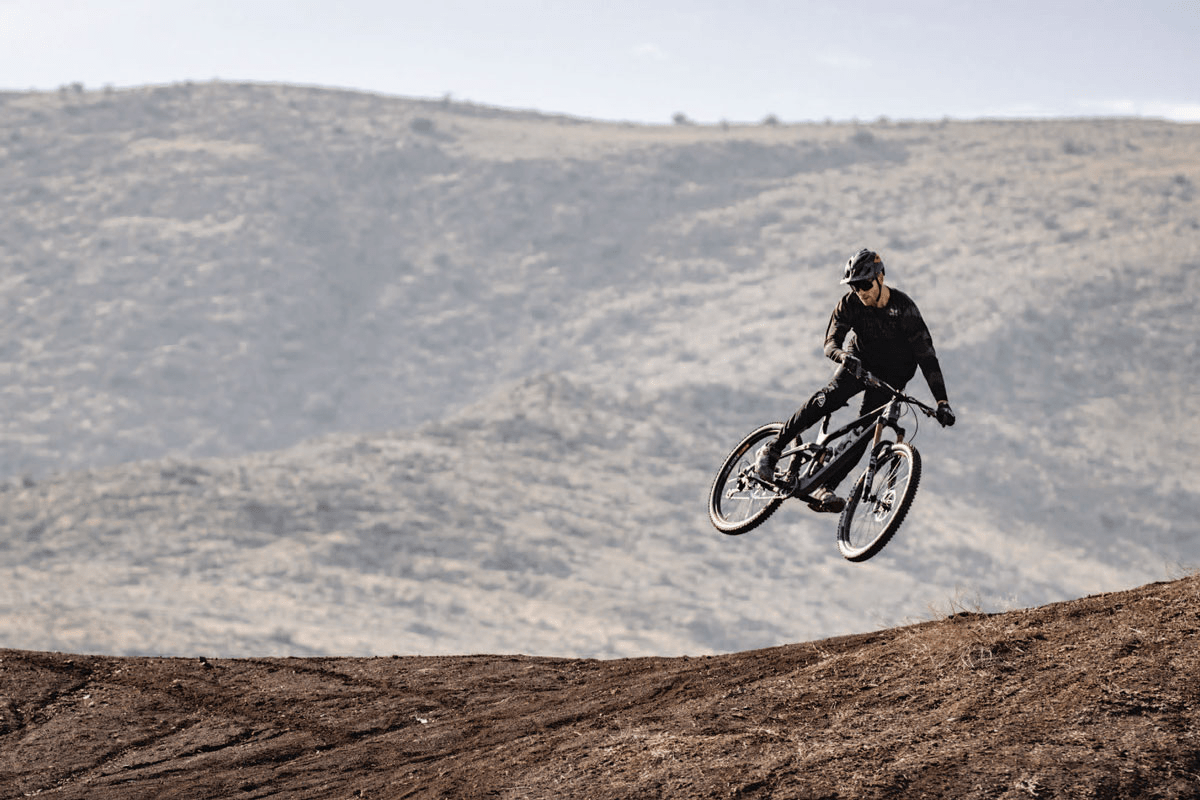
My estimates of what to expect are usually gained from Google Earth reconnaissance, made easy by the lack of tree growth which allows me to identify any marginal hiking trails I have big ideas to scale. Each time I find a new zone to explore, I can stretch the ride in any direction on successive visits. In the year to date, these experiences often result in a feeling of conquering new terrain and big mountains that few, if any, have ventured on by mountain bike. The combination of my riding experience and the latest innovations in mountain bike technology, take me to trails and mountains I never thought possible when I first started riding mountain bikes in 1998, on a 24-inch wheel hardtail, at the age of 11.
Since the locals tend to lap out the same riding spots, they don’t often possess extensive knowledge about the wider mountains or trails. Sometimes, I find myself introducing locals to new trails and new ways of riding their local mountains, however, when it comes to the lower slopes (for group riding sessions) their expertise is unrivalled. I’m not sure if this is due to their preference to lap downhill trails with their mates or if it is more of a forced choice due to the economic situation influencing the types of bikes they ride.
More hardcore enduro or all-mountain style riding isn’t a thing here, yet.
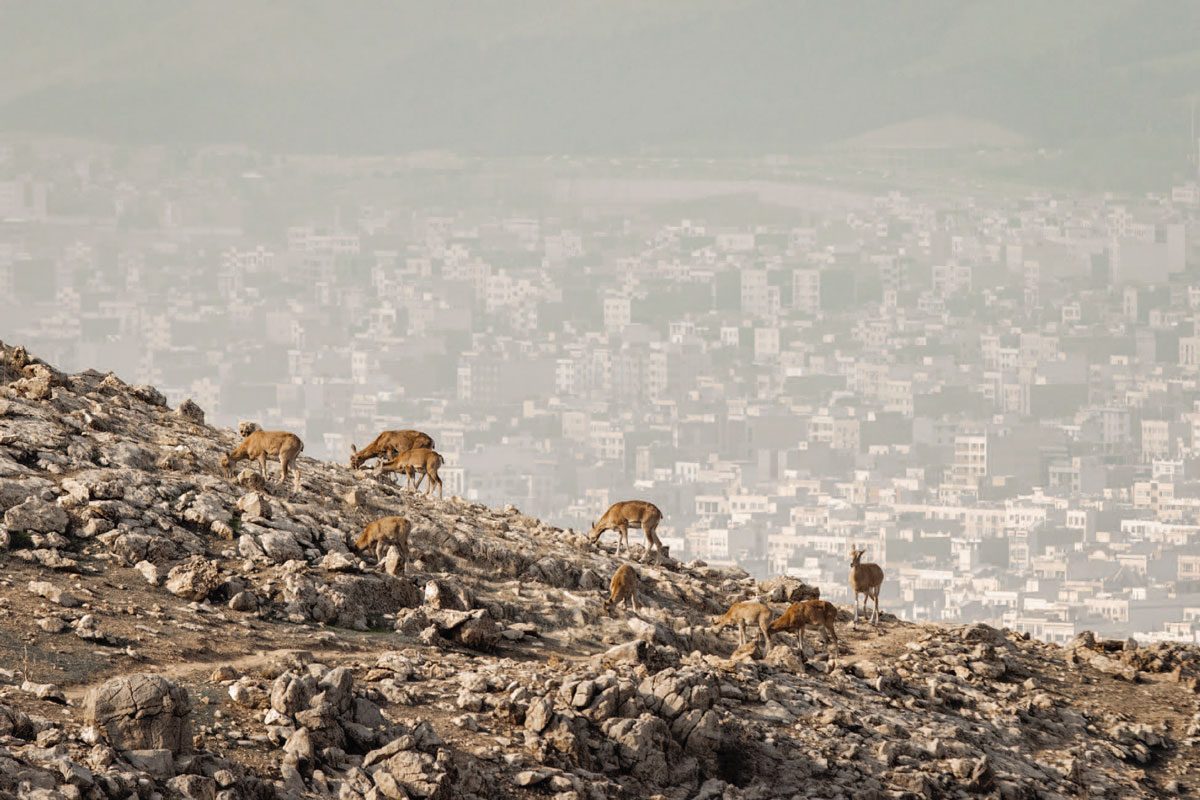
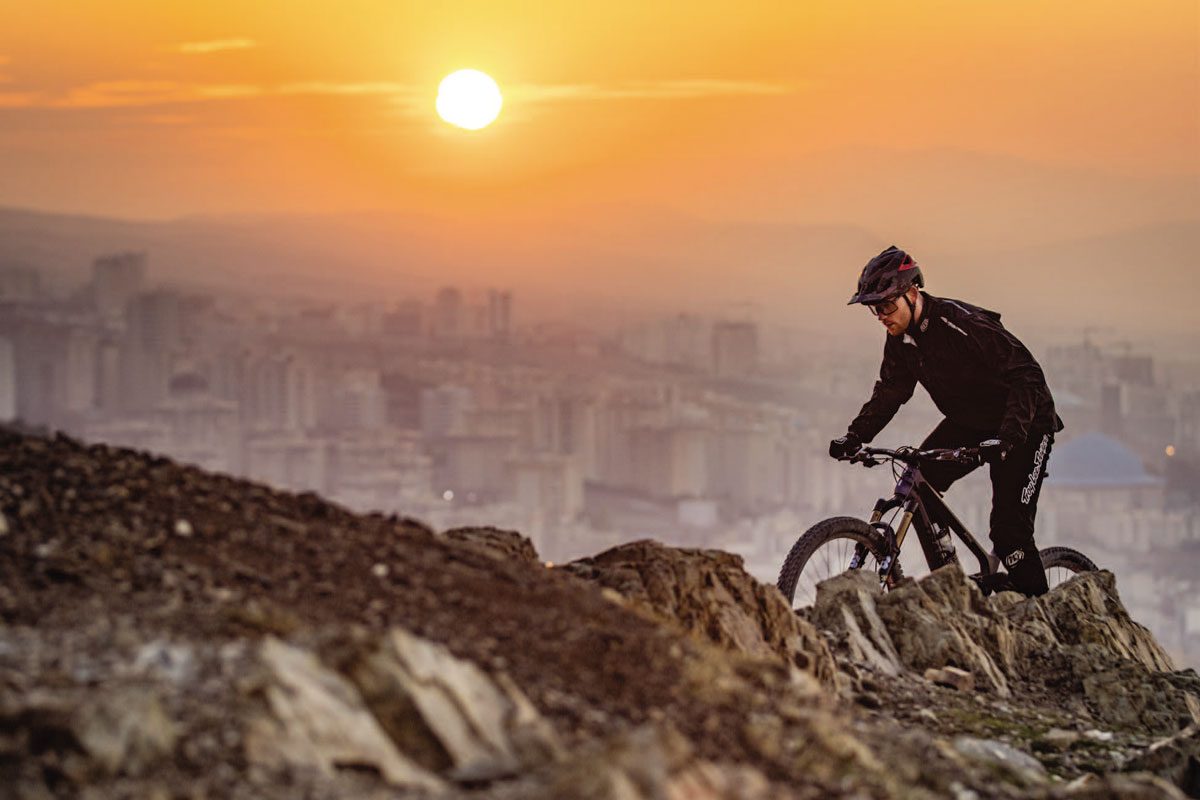
The people here find themselves in quite a remarkable situation, with rising political pressure on a government that has been under economic sanctions in some form or another since the revolution in 1979. In addition, the value of the Iranian Rial (IRR) is unstable, and there are high rates of inflation – with 45% reported for the year to date. This, combined with comparatively low salaries and wages, significantly reduces the peoples’ ability to travel outside of Iran and purchase international goods, such as mountain bikes. For example, having the opportunity to purchase late model mountain bikes comes at an exorbitant cost, due to trade restrictions, and this is without factoring in the price of such items when converted to IRR from Euros or USD. The middle class here finds itself anxiously cut out of participating in the world – but this in no way dampens their enthusiasm for the pursuit of adrenaline on the bikes they do have. For mountain bikers here, like the rest of us, the sport allows them a sense of escape and freedom in the pursuit of the divine adrenaline rush.
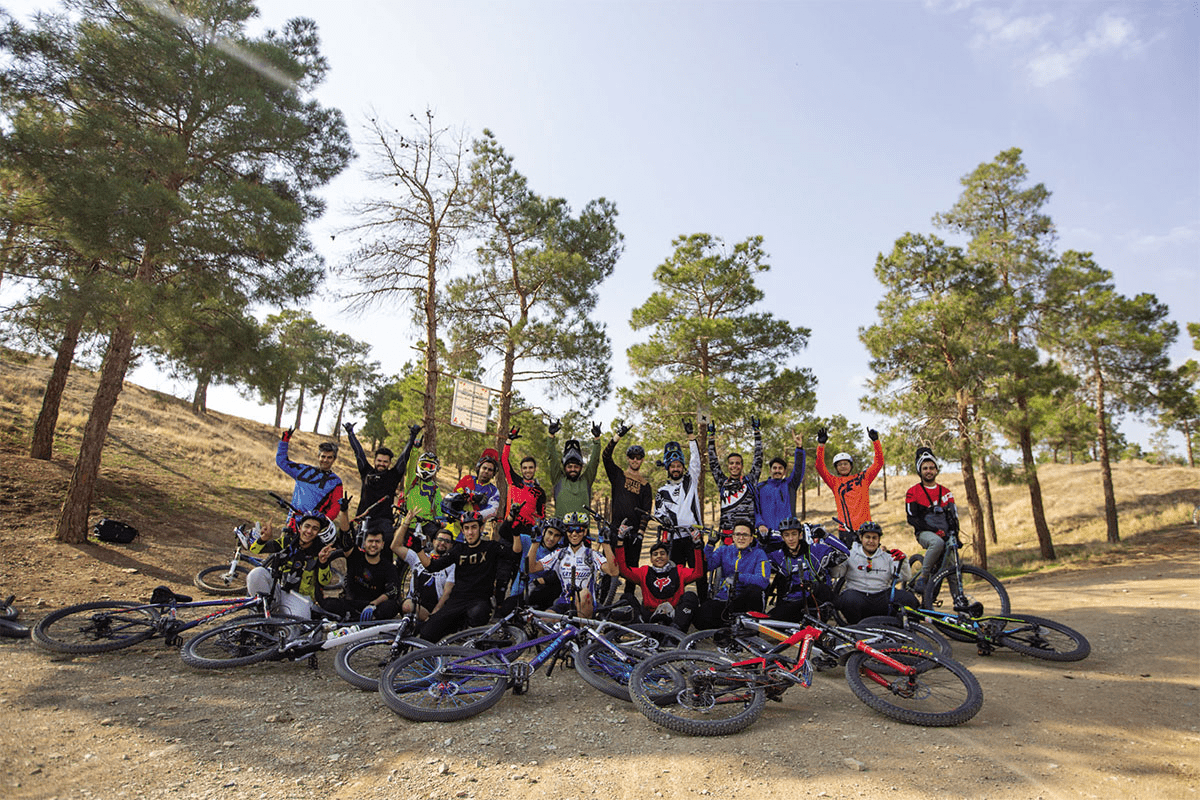
I commonly find myself riding in large groups of locals, where communication requires my very slowly evolving Farsi language skills as there are usually few English speakers present in the group. One thing in particular that stands out is the value of the shared experience of riding bikes. The multitude of differences between this place and my homeland, and myself and the local people, melt away when we share the ride together. The good times generated and shared by all, from the riding experience, demonstrate the overwhelming similarities among humans the world over, regardless of a given situation. In a country that is painted so differently to my own, the power of the bicycle as a vehicle for a shared experience that bonds people together, cannot be underestimated.
Words: Cam Cole
Photography: Ali Salsali
Feature: No Reservations
We all dream of riding trails straight out of our front door. The reality is, though, that’s a luxury few of us have, unless we’ve set our lives up in one of a few towns where it’s possible. For most of us, there’s either a ride on the road, or a car journey, before we can get our trail fix. Nowadays, however, the accessibility of car camping and campervan setups means it’s possibly to literally wake up and ride right from your front door. And, that front door could be in a new location every day – or even multiple places in one day.
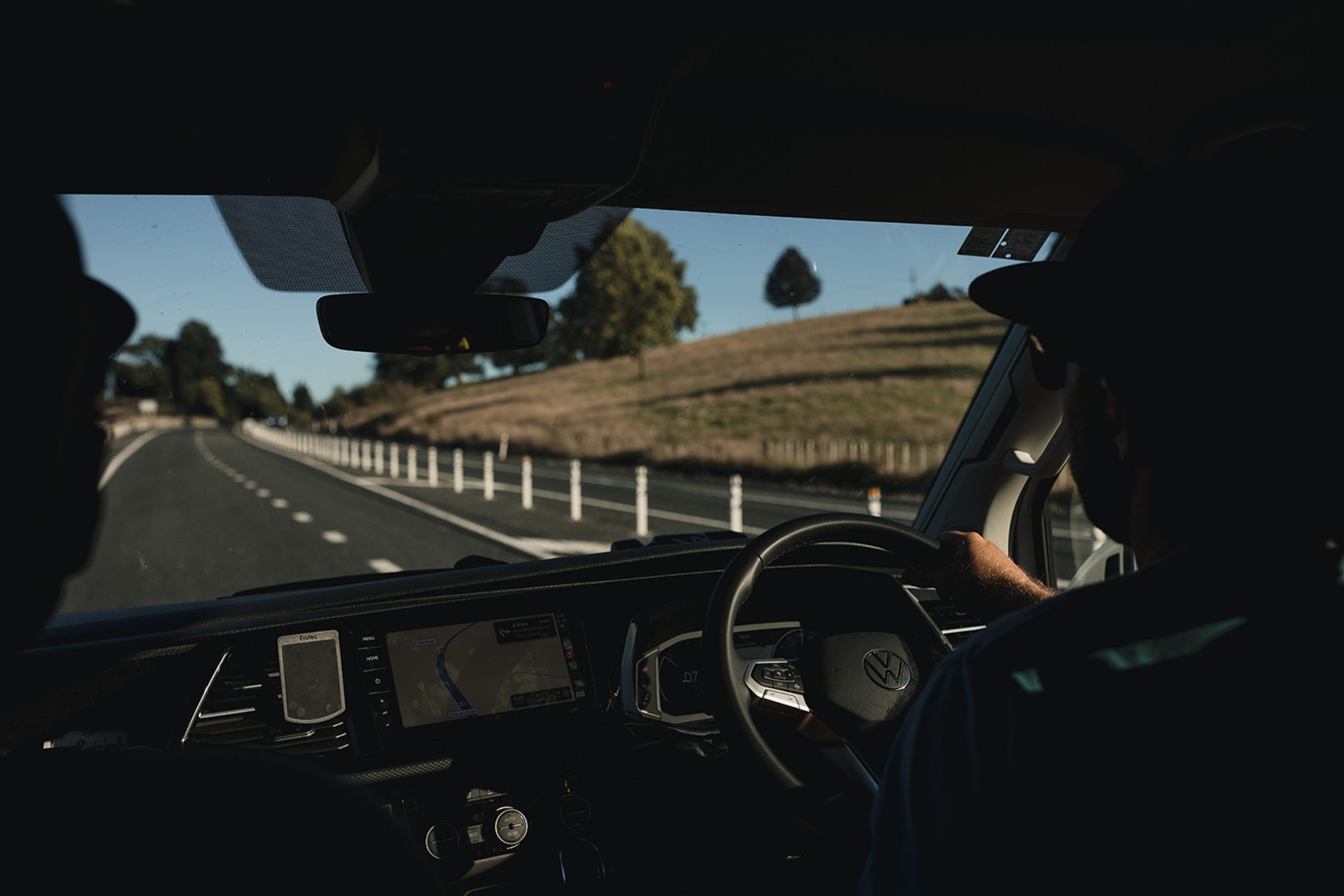
Our home away from home rolled up the driveway; a shiny new VW California. The middle offering in the all-new California range, this campervan gives serious modern-day Kombi vibes. With an electro hydraulic pop-up roof and roof bed, plus a self-contained kitchen, there was ample room for us to sleep, eat and chill in between rides.
Bags in the back, bikes on the rack, a couple of espresso shots from the home machine and we were ready to roll. “Where are we off to then?” was the question. We’d made no real plan and with the van being our kitchen, sleeping quarters, chill zone and changing room we needed no reservations of any sort. We had a vague direction to head, and a time we needed to be home, but between then and now, the itinerary was pretty loose – actually, it was non-existent. As we headed towards our ‘loose’ destination of the Coromandel Peninsula, we knew our plan would take shape and unfold as it needed to.
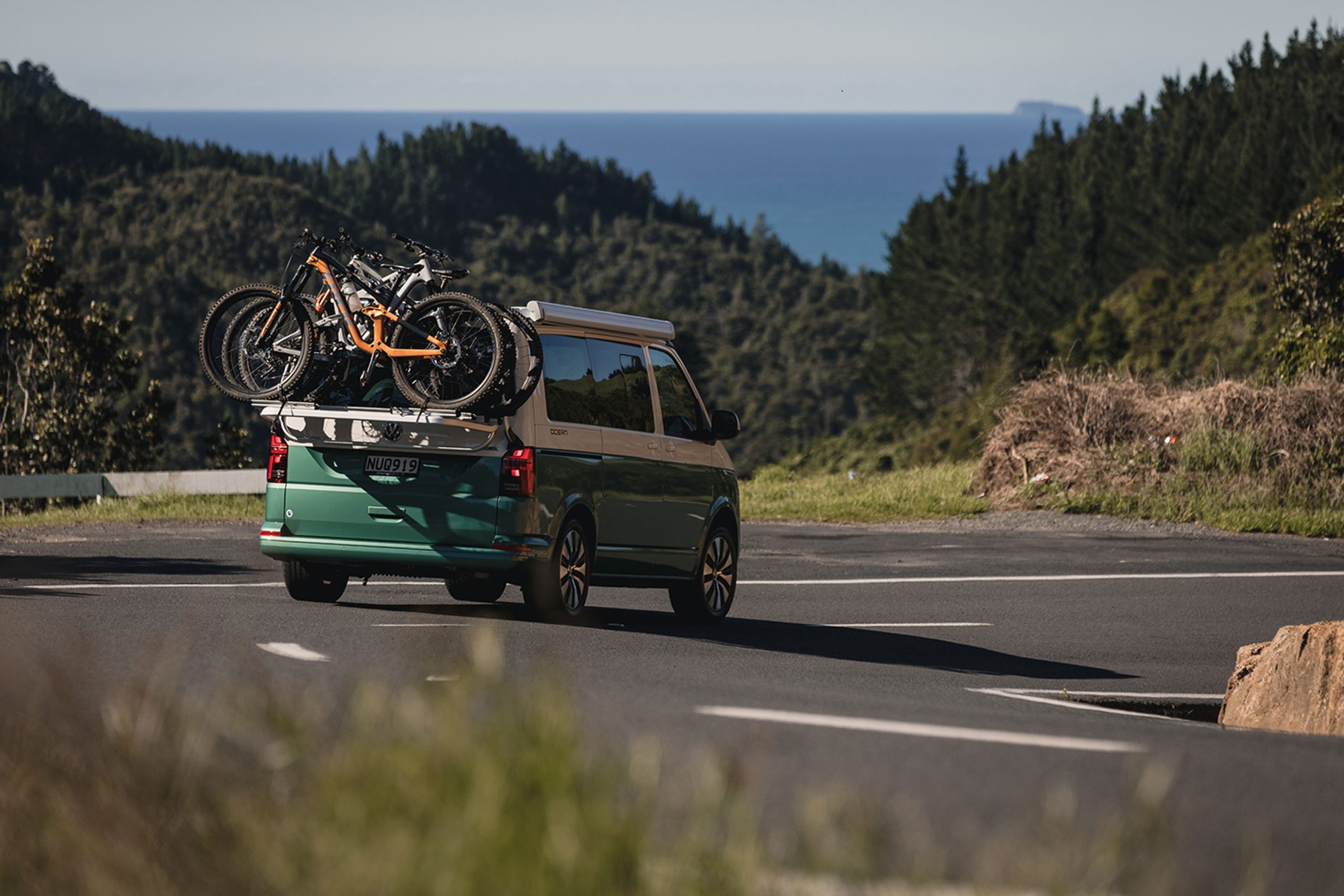
After some discussion, we decided to head to the town of iconic thermal mineral spas and a big ass mountain: Te Aroha would be our first stop and we were there for a good time, not a long time. Having ridden the ‘Gum ta Native’ trail eight or so years ago, I was keen to go back and see if it had seen any updates. NZ’s endless summer was in full effect and within minutes of beginning our climb two things were obvious: one – we should have been at a beach somewhere, as it was too hot; and two – with an almost-clear blue sky, the sun was piercing through the bush canopy meaning capturing any good photos was going to near impossible, i.e. a MTB photographer’s worst nightmare. We continued our climb up, with intentions to get to the high point of the trail and descend back down the way we’d come. The trail seemed to be smoother than I remembered – maybe it had been cleared of rocks, maybe it had been mellowed due to the amount of traffic over the years, or maybe it was just because I was now aboard a 160mm travel 29er, not a 120mm travel 26” wheeled steed?
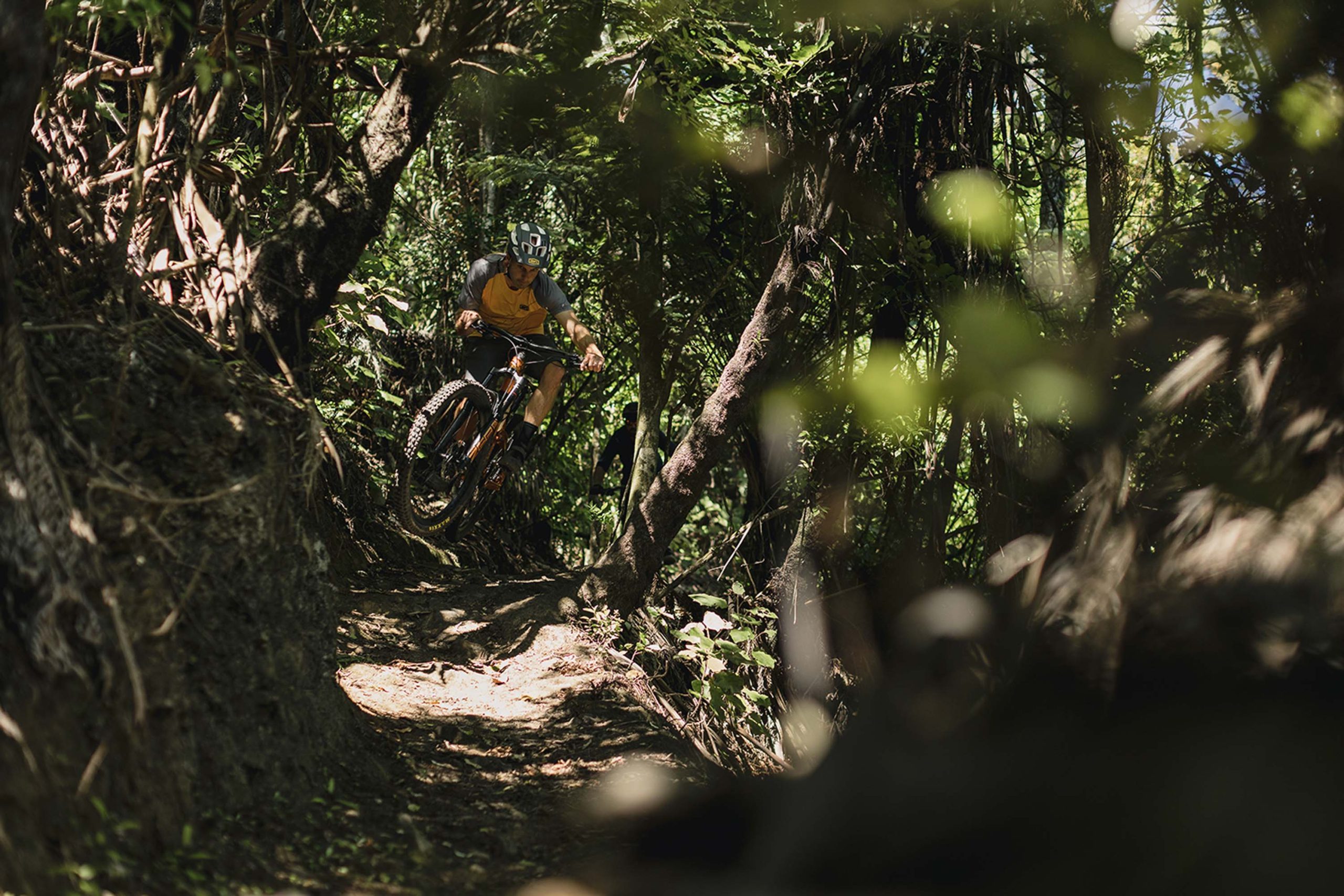
Two thirds of the way up the hill we decided it was a bust; the juice simply wasn’t worth the squeeze. Rigs turned 180, lockouts off and down we went. Descending was a blast: some fun, flowing turns, a couple of little bridge features, a few foot-out-flat-out moments, a couple of scarily tight trees, and suddenly we were back at the van, albeit a lot sweatier than when we left.
“What’s next?” “Ice-cream, surely?!”
“Yeah boi!”
A minute later were back in the centre of town choosing which Tip-Top flavour would hit the spot, then back in the van for some shade and chill time before we headed off. Maybe there are some hidden nuggets of trail hidden somewhere in the Domain Reserve (we know there is further up the hill outside of the domain, but our lips are sealed), and given more time to explore – or a local guide – we may have found some, but we would need more time to find that out. The trails have gone the way of the miners in the 1880’s, in that they have been somewhat forgotten about as time has marched on. I’m picking that, as Te Aroha is a small town, with an even smaller riding community, there’s a lack of interested parties to further develop what could be a MTB destination on par with some impressive small-town parks around the country. For now, though, it’s worth a quick stop if you’re passing through, if for nothing else other than an ice cream and a dip in the thermal baths.
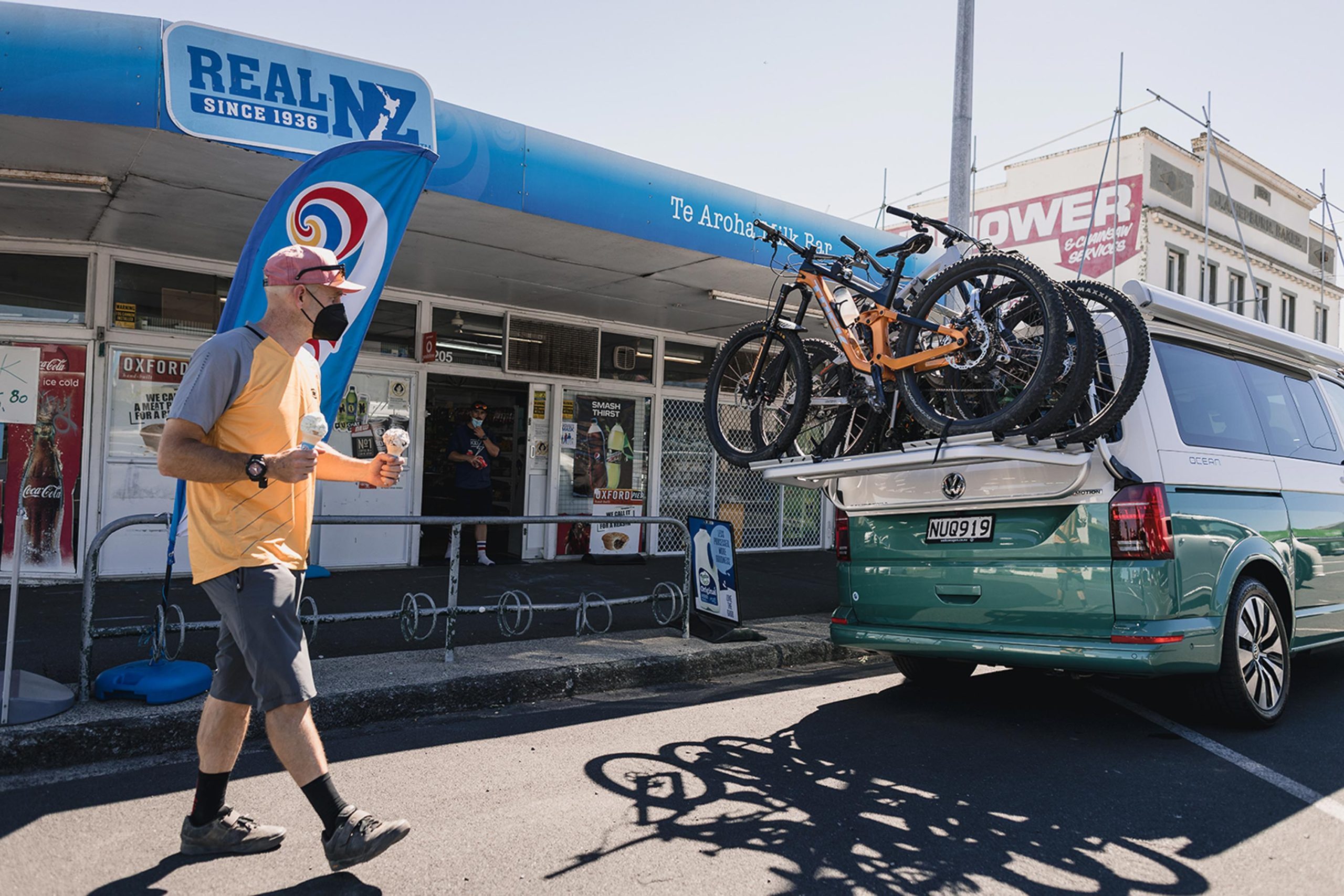
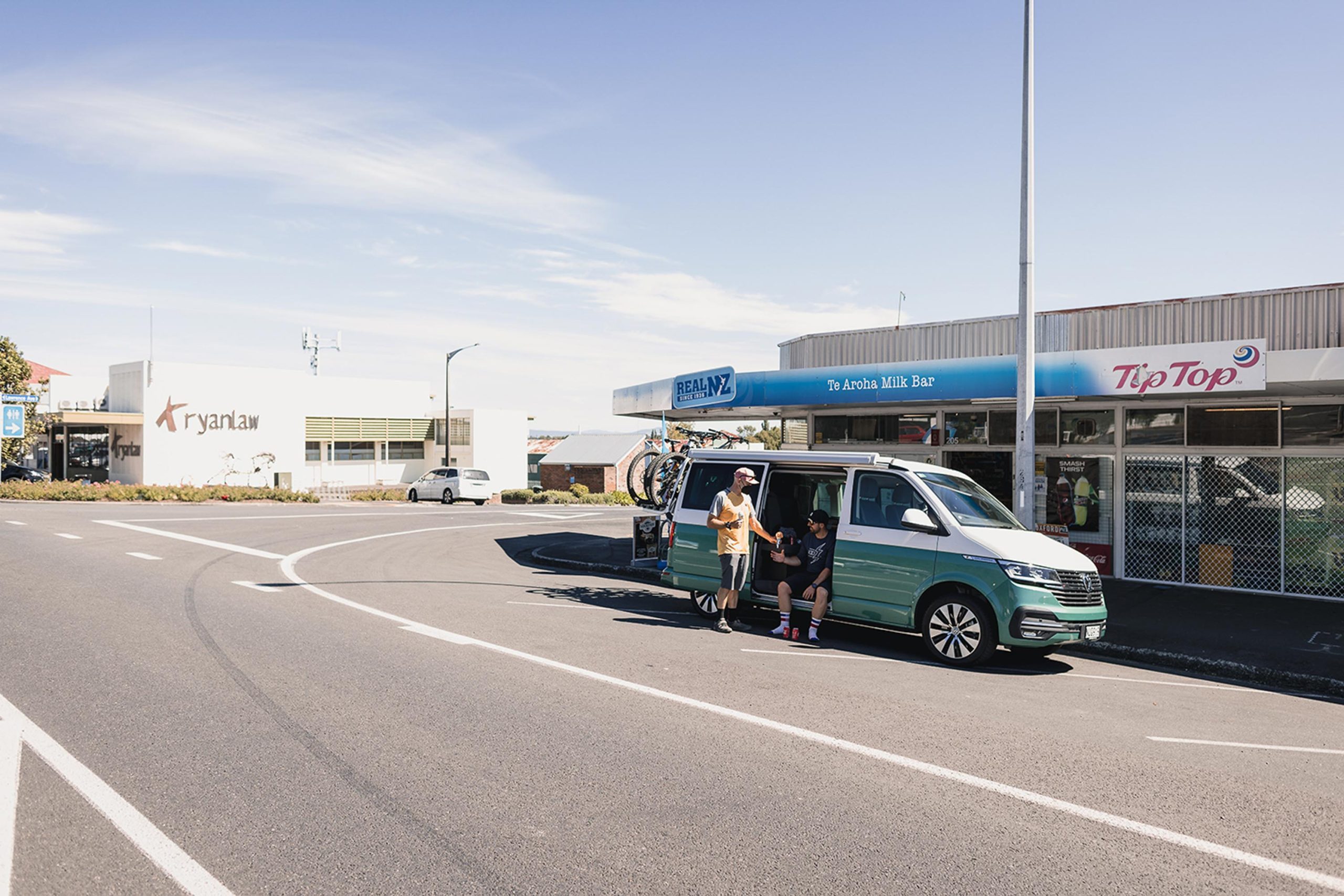
Back on the road, we’d decided Whangamata could be the go – again, a spot I’d ridden a number of years ago. With rumours that some trails had been refreshed recently – but also of logging activity in the area – we weren’t quite sure what we were in for. Regardless, the stoke was high. With the trails off limits until 5pm, due to logging, we took a quick drive to check out where our coffee the following day could be found and hitthe supermarket for supplies. Much like our entire trip, we had no plan for food. Fortunately New World had a handful of recipe cards conveniently located by the door. Recipe cards in-hand, the three of us went separate ways, loading up and reconvening at the checkout with our dinner ingredients sorted.... although we still didn’t know quite where we’d be cooking it.
Arriving at ‘Fred’s Carpark’ we unhitched the bikes, checked the map board, ensured we didn’t get tangled up with the logging, and off we went. With limited time before sundown, we figured the best plan was to scope some spots, shoot what we could, hopefully bag a golden sunset shot or two, then return the following morning for more.
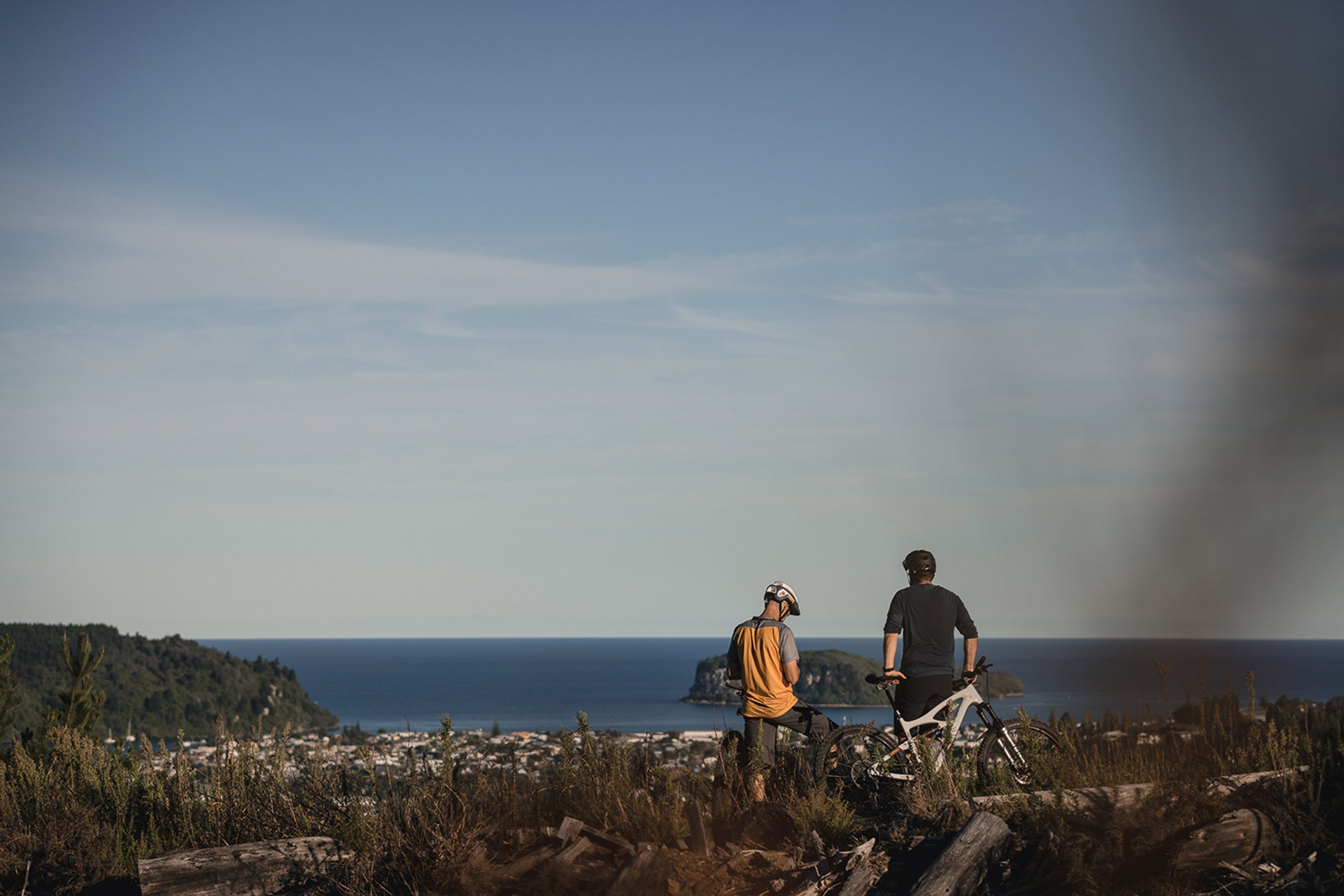
Trail names at the Whangamata Ridges MTB Park hark back to the surfing roots of the town, with many having surf related or marine-centric names: Pipeline; Over the Falls; and Aqualung, to name a few. Working our way up the hill, the light was looking a little better than Te Aroha, but photo-man-Cam was still not stoked. I was, though; I’d ridden here before but back then the trees were about as tall as I was, now they’re many times my height (and I haven’t grown at all!). With the tree cover comes better dirt; what was oncerain-rutted and dry-as-a-bone is now nicely packed, at times blue-groove, and on the day we rode, perfect!
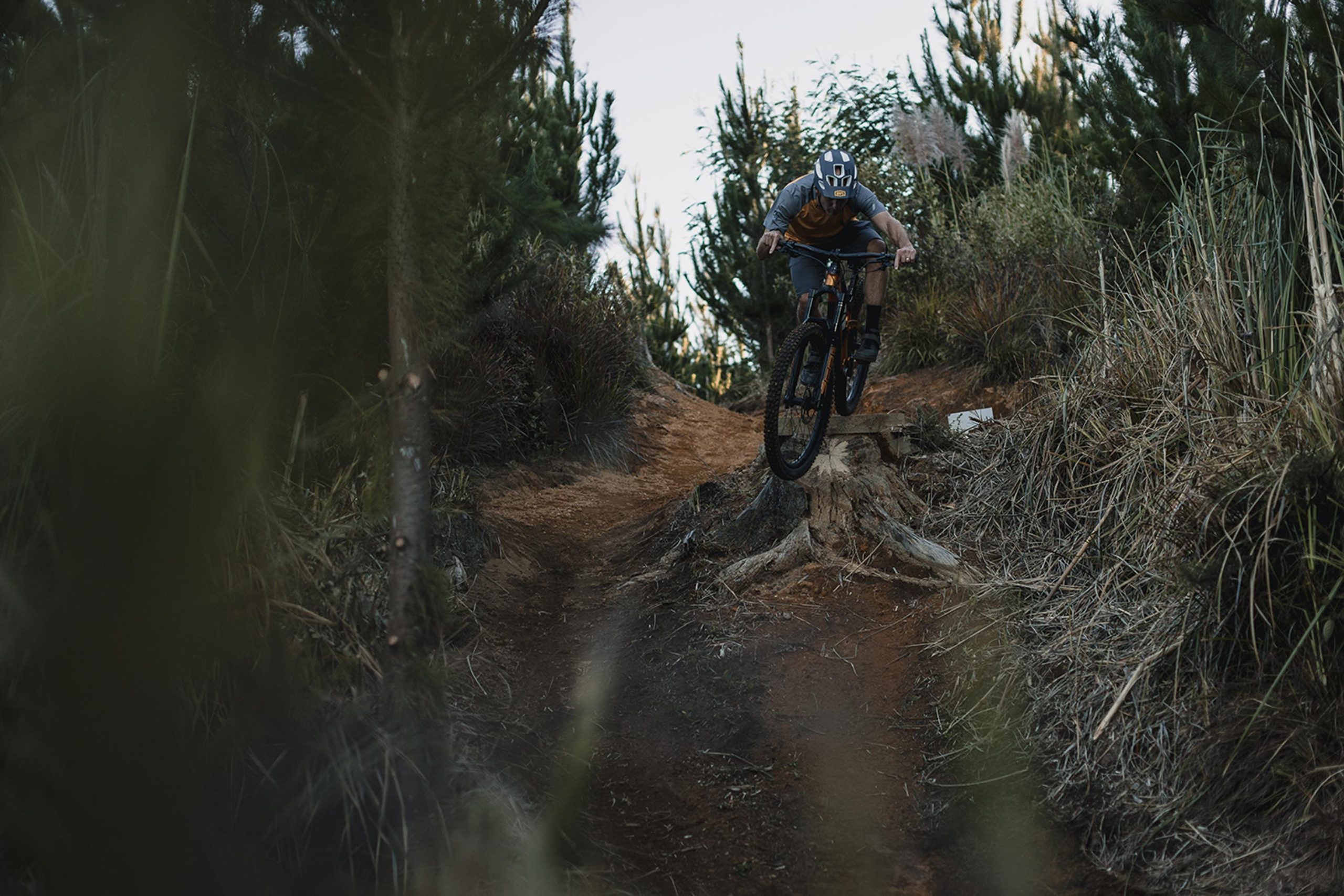
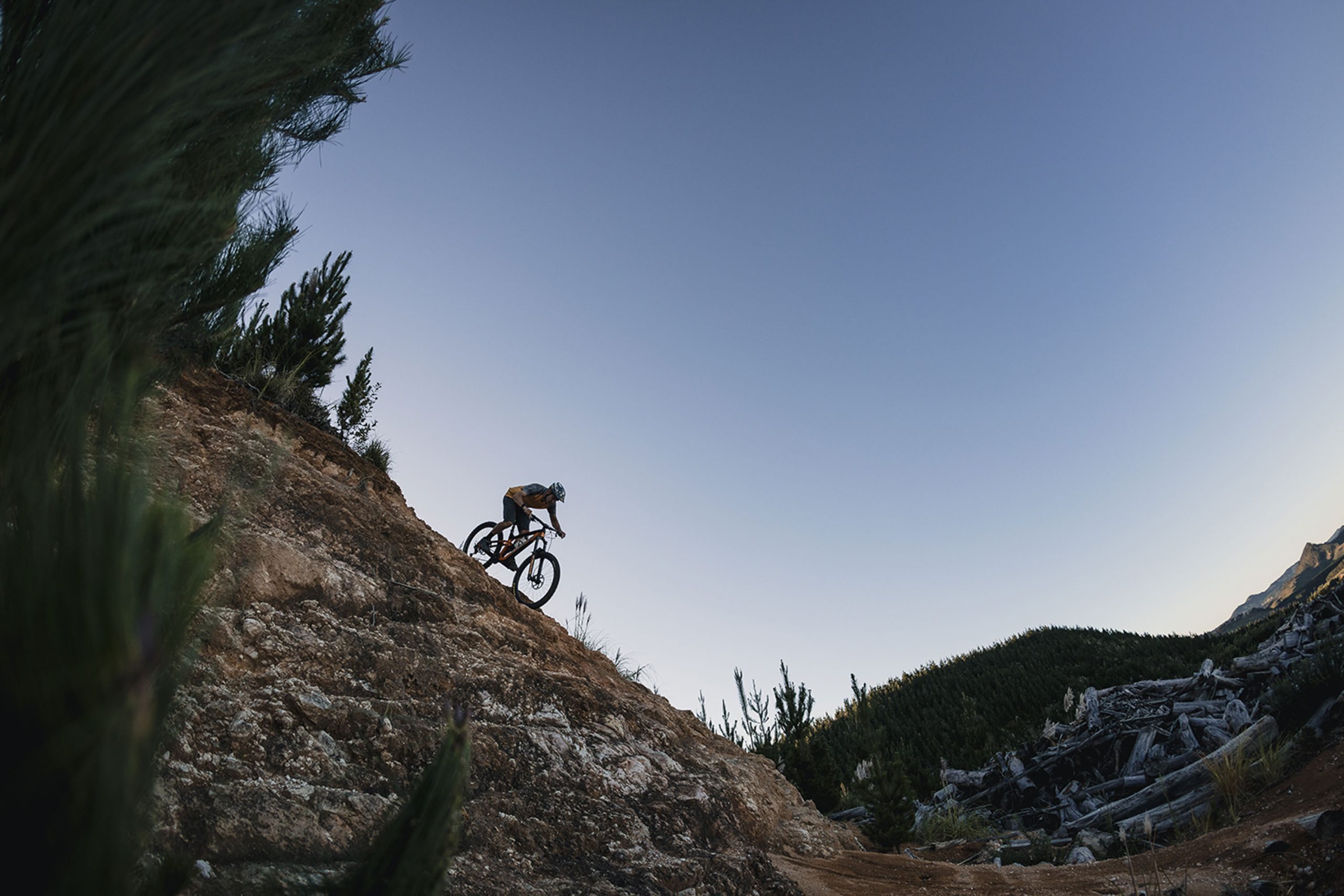
The climb up was a cinch; a wide and well-graded trail wound its way to the upper slopes of Causeway Road, which dissects the core trails of the park. Unfortunately, the trails deeper in the park were off limits, so we concentrated our efforts on cutting quick laps up and down each side of Causeway Road. First pop was Tube Cruiser, a Grade 5 flow trail with some sweet jumps and berms, all pretty crisp! The curse of the dappled light was following us around again, so we shot back up Aqualung, this time to check out the view from near the highpoint of Causeway Road. As we climbed, the unsightly pile of logging/the view rolled out over the green of grown pine, across the town and out to sea; a stunning sight ignited by the late afternoon sun. Taking note of the situation, we knew we were on borrowed time and it would soon be sundown.
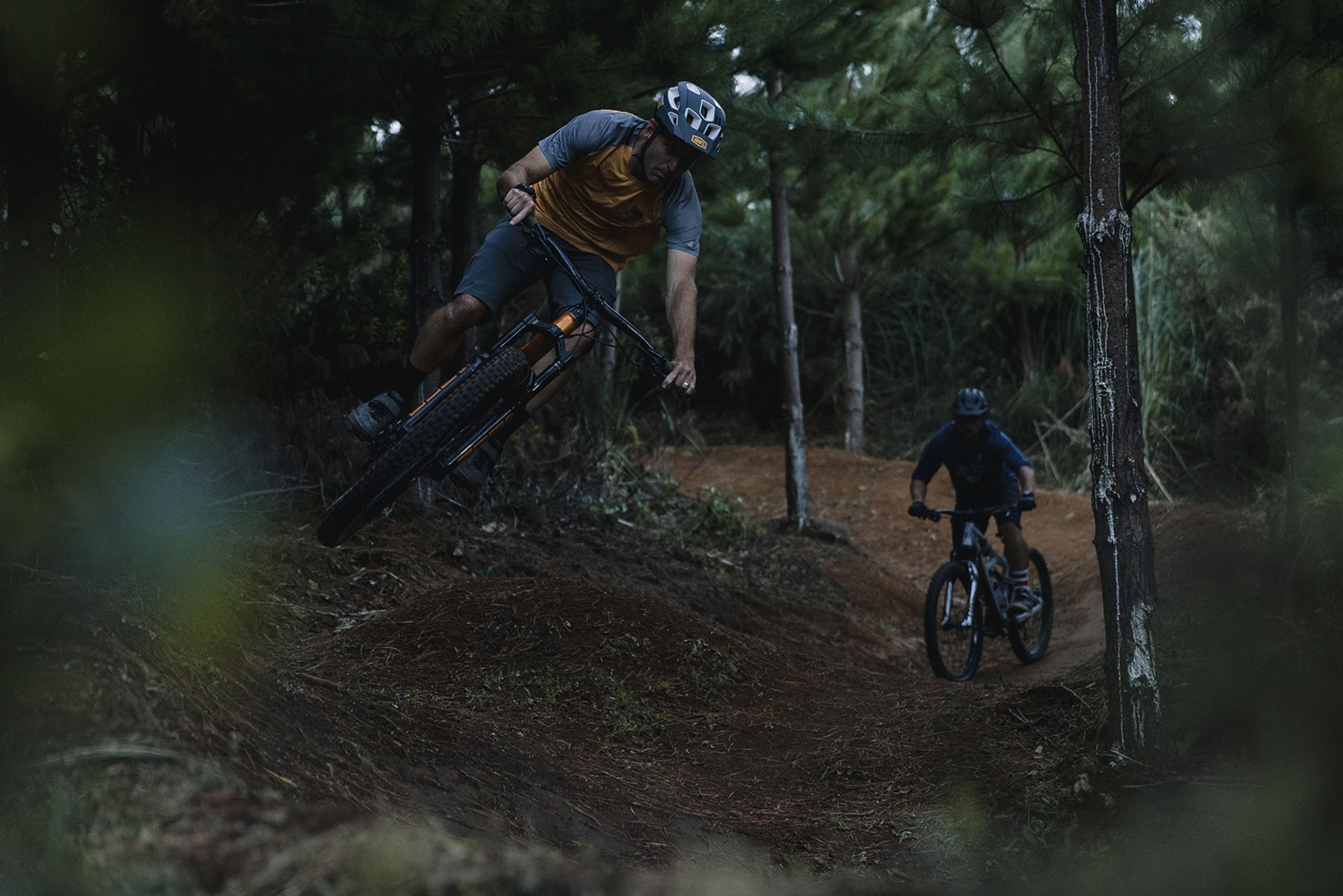
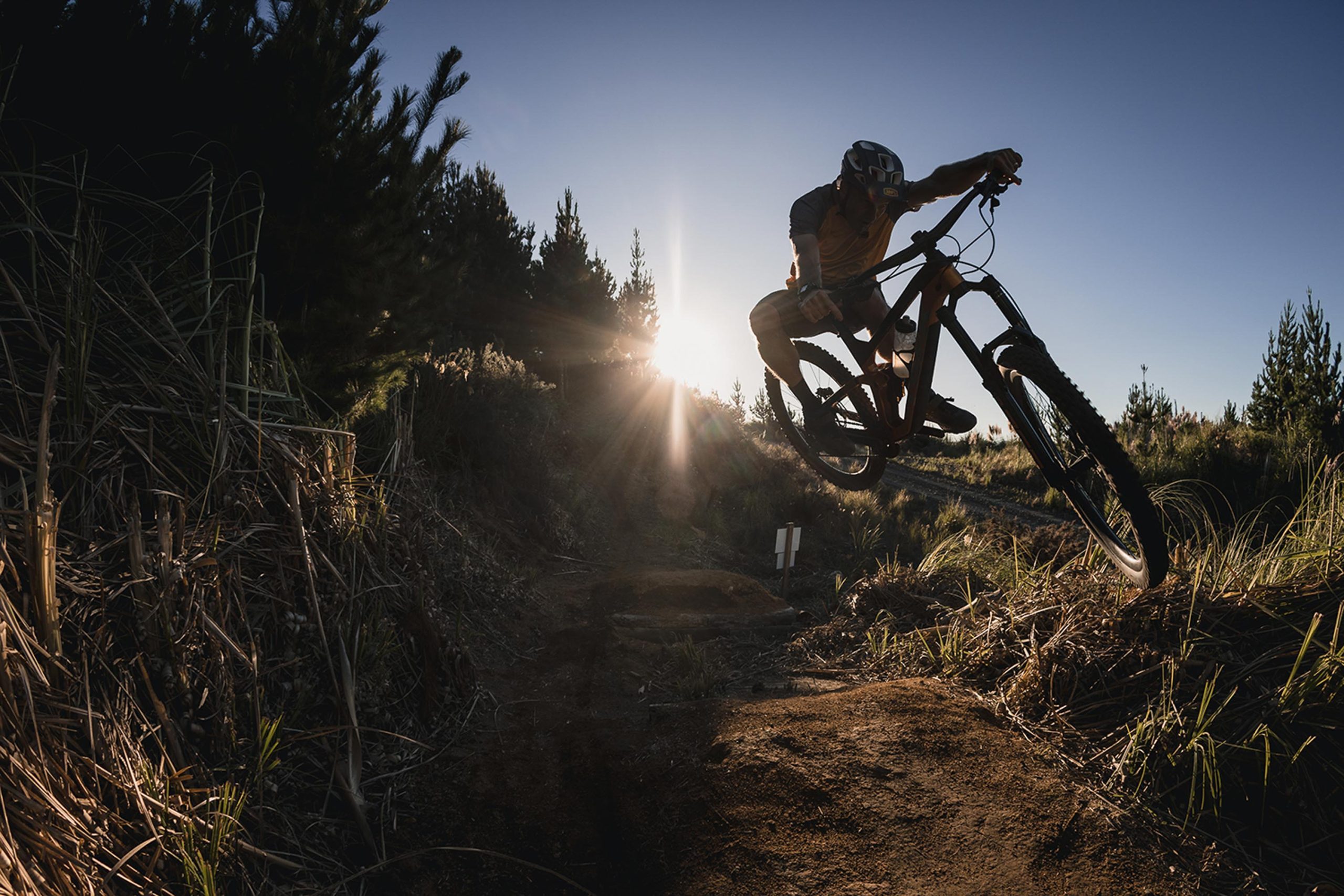
We hooked into Just Saying, a short n’ sweet number with the main feature being a nice floaty gap jump. With the sun just in the right spot, I got to work trying to make it look like I knew what I was doing on the bike, and Cam got his shutter finger working (it’s just point and shoot right?!). A few hits later and we were done. Popping onto the road, we headed up to No Bull for a gander at its infamous final feature: the rock-roll. Not highly technical, but not entirely straightforward, take the wrong line and you’re in for a rough ride. The rightline was just the right blend of steep and sketchy. “Guys, guys, guys – turn around and ride up that bit again!” You know something serious is going down when the photographer gets this excited. Liam and I did what we were told; riding and re-riding a few sections of climbing trail, unsure what all the fuss was about. Cam showed us some of the shots and we could finally see what it was all about! Like the miners who once explored these hills, we’d struck gold: photographic gold. The light was perfect, as was the scene; Liam and I did our job adequately, and that was a wrap.
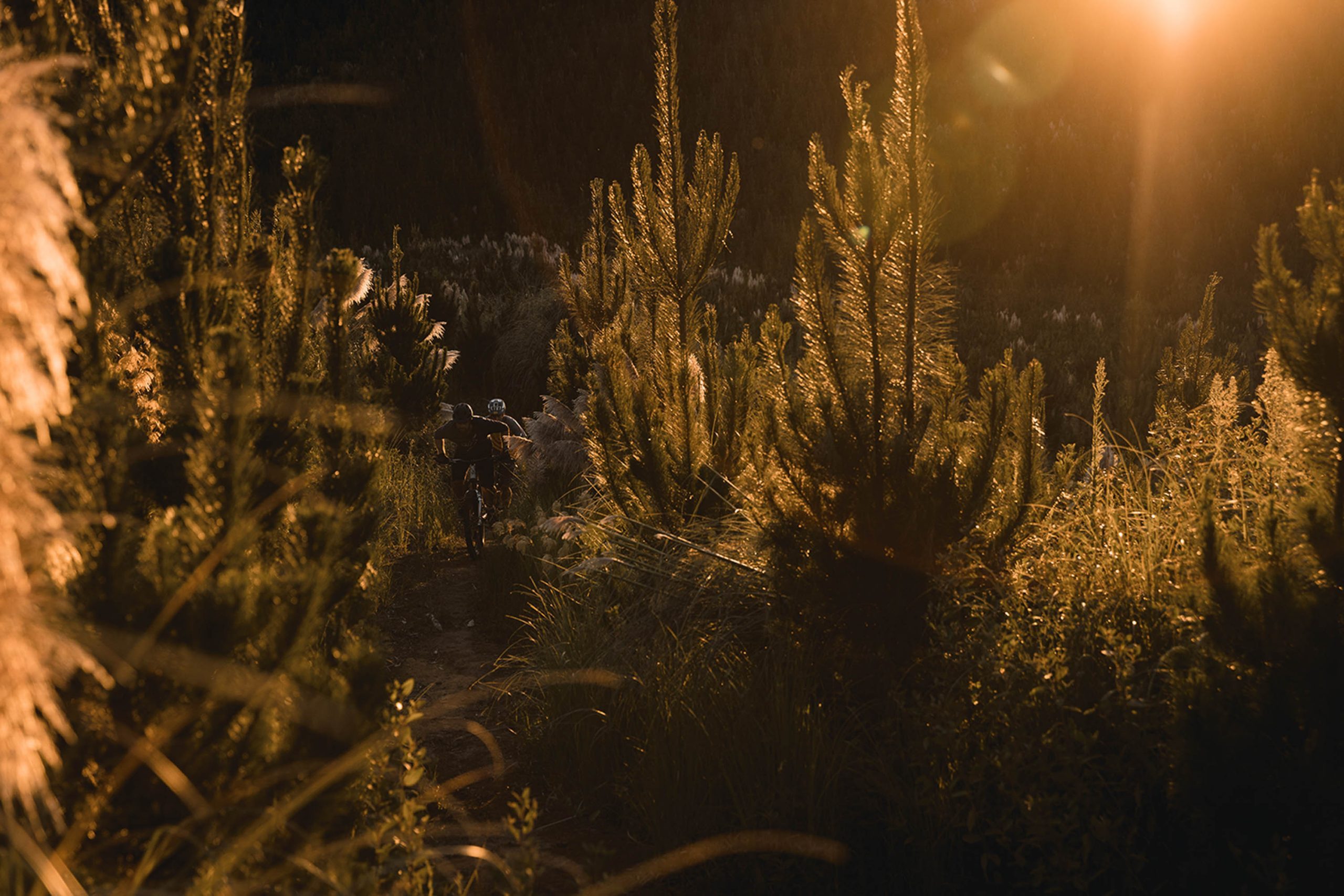
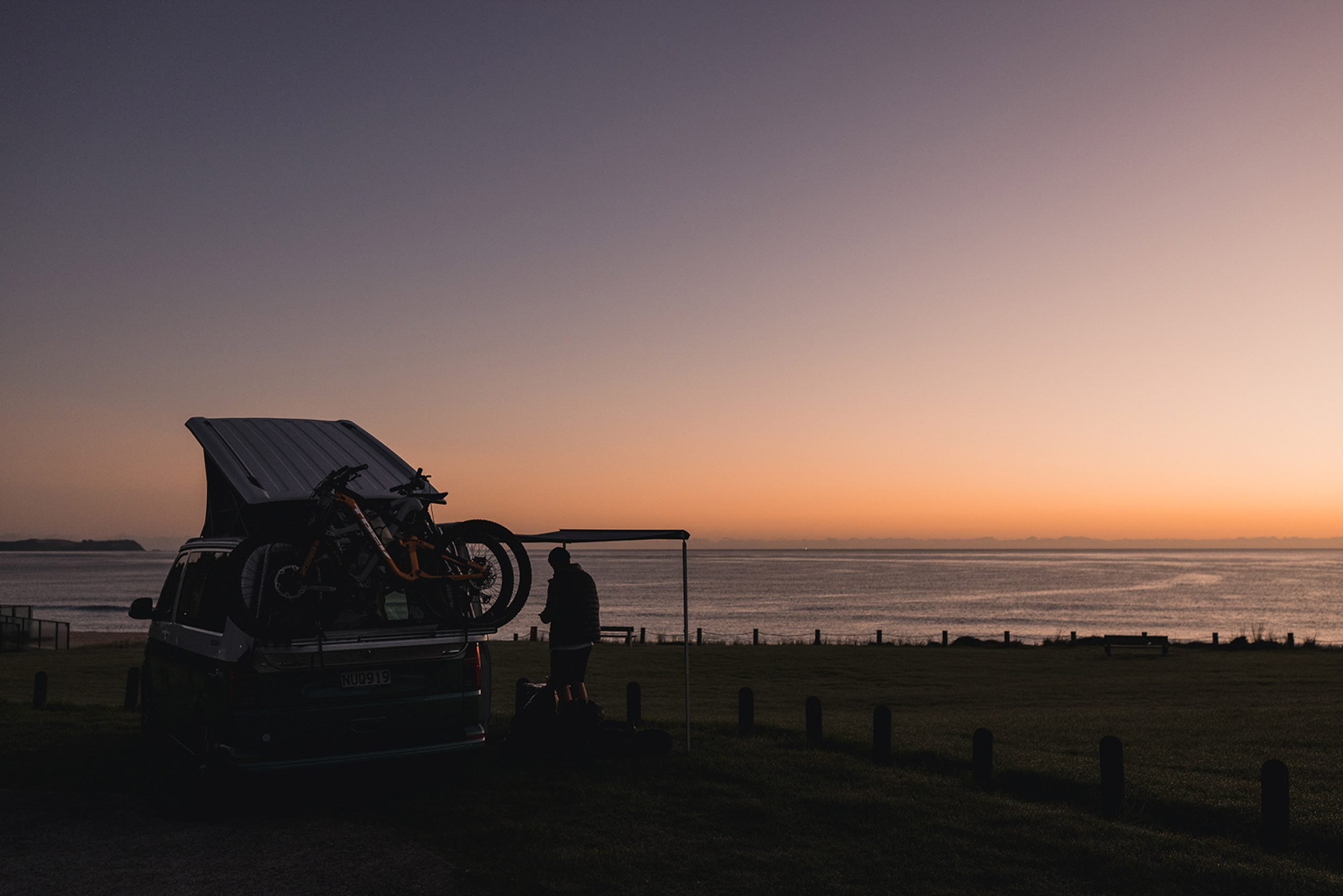
Back at the van, we cracked a coldie and reflected on our day: the ground we’d covered, the challenges and the wins. It was dark, we had nowhere to be, but we were hungry, and we did need to find a spot to park up for the night. Fortunately, there are a number of freedom camps around Whangamata and its surrounding areas. We didn’t want just any camp spot, though, we needed the perfect spot.
After operating multiple phone apps, and seemingly an hour of driving around in circles (I did mention we had no plan), we found the ideal spot. Setting up the California for the night was super simple – it took no more than five minutes to get the roof (and extra bed) up with an auto switch. We got the awning out and flicked the driver and passenger seats around inside to give us a comfortable indoor space for the evening. This functionality ensures the California is the perfect base camp in any kind of weather! Mood lighting was the icing on the cake, giving our setup a homely ambiance. The best thing about the campervan is that – unlike camping – we knew we just had to put everything back in its place the next morning when we were ready to head off; no tent pegs to pull out or ground sheets to roll up and repack – that’s a huge win! The nostalgic vibes of this camper may make heads turn, but it’s the ultra-modern specs and features that really make it shine.
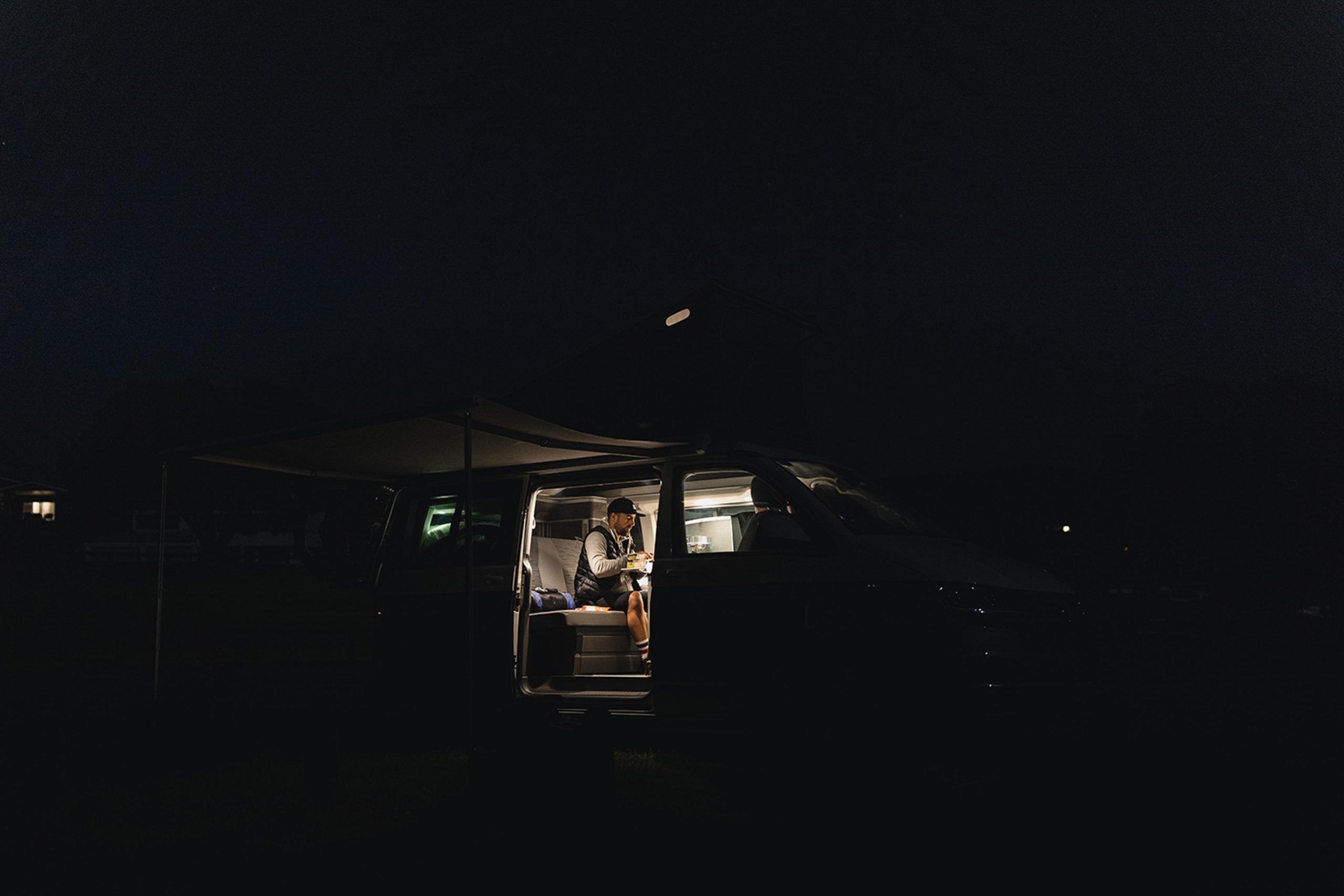
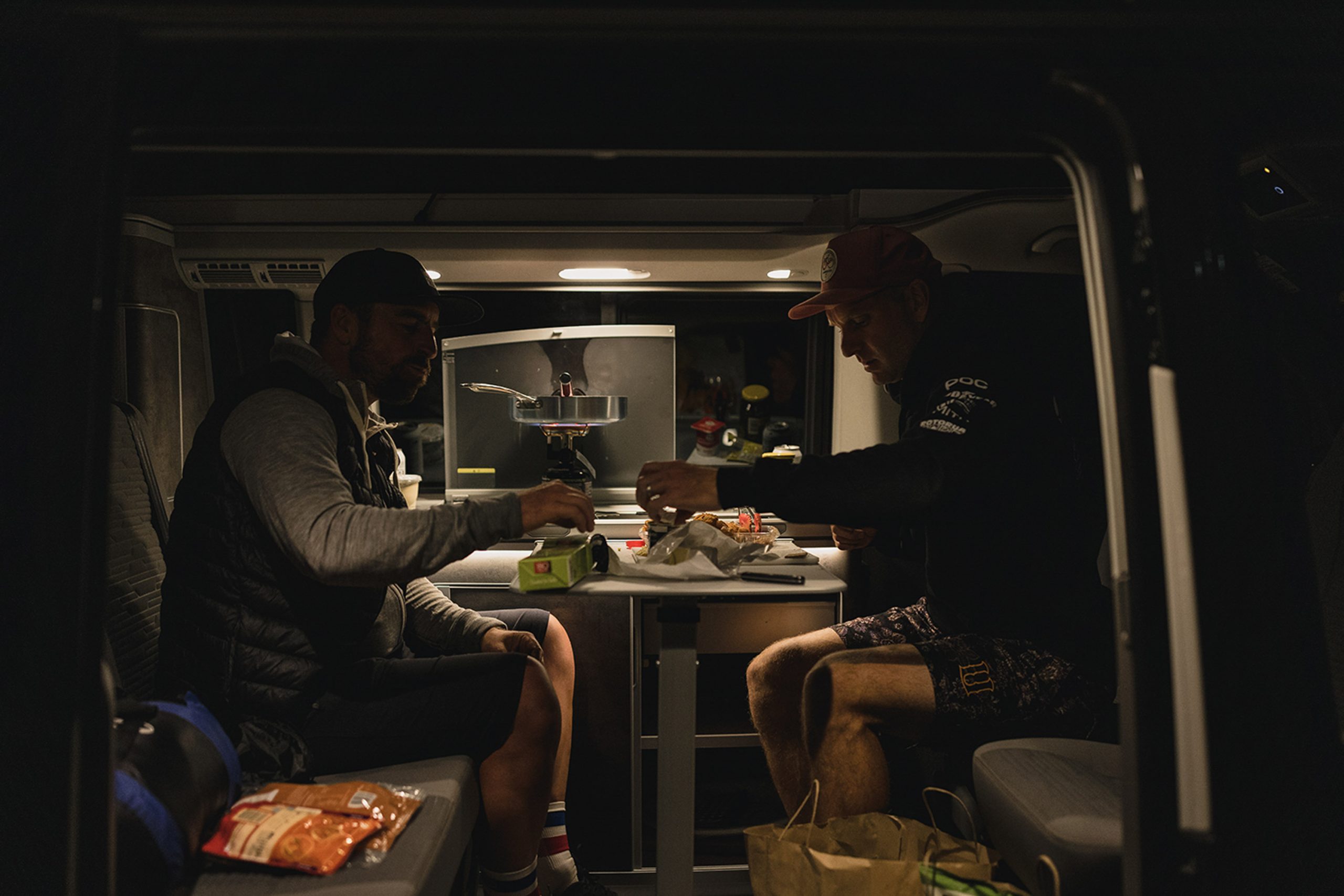
We’d be greeted with a perfect sunrise the following morning, and could dive in for a pre-breakfast swim, just a stone’s throw from where we’d sleep. Onemana Beach ticked all the boxes and we settled in. With instructions not to cook curry in the van, we figured some spicy Mexican would be fine, so got to work, recipe cards in hand. We literally solved all the world’s problems whilst eating our burritos and as the clock ticked into ‘tomorrow’ we slid the door shut and drifted off to sleep; the aroma of freshly cooked Mexican still hanging in the air.
The 6am wakeup came as rudely as you’d imagine after a scratch over five hours sleep. Blurry eyed we prepped ourselves for the sunrise; Cam started clicking, and Liam and I prepped the first round of coffee. This was what every morning should be: coffee and good yarns whilst watching the sunrise, followed by a swim (which doubled as a bath) and finishing with bagels and granola as the sun came up. The trails were shouting, so we rolled the awning in, dropped the pop-top, and set a course once again.
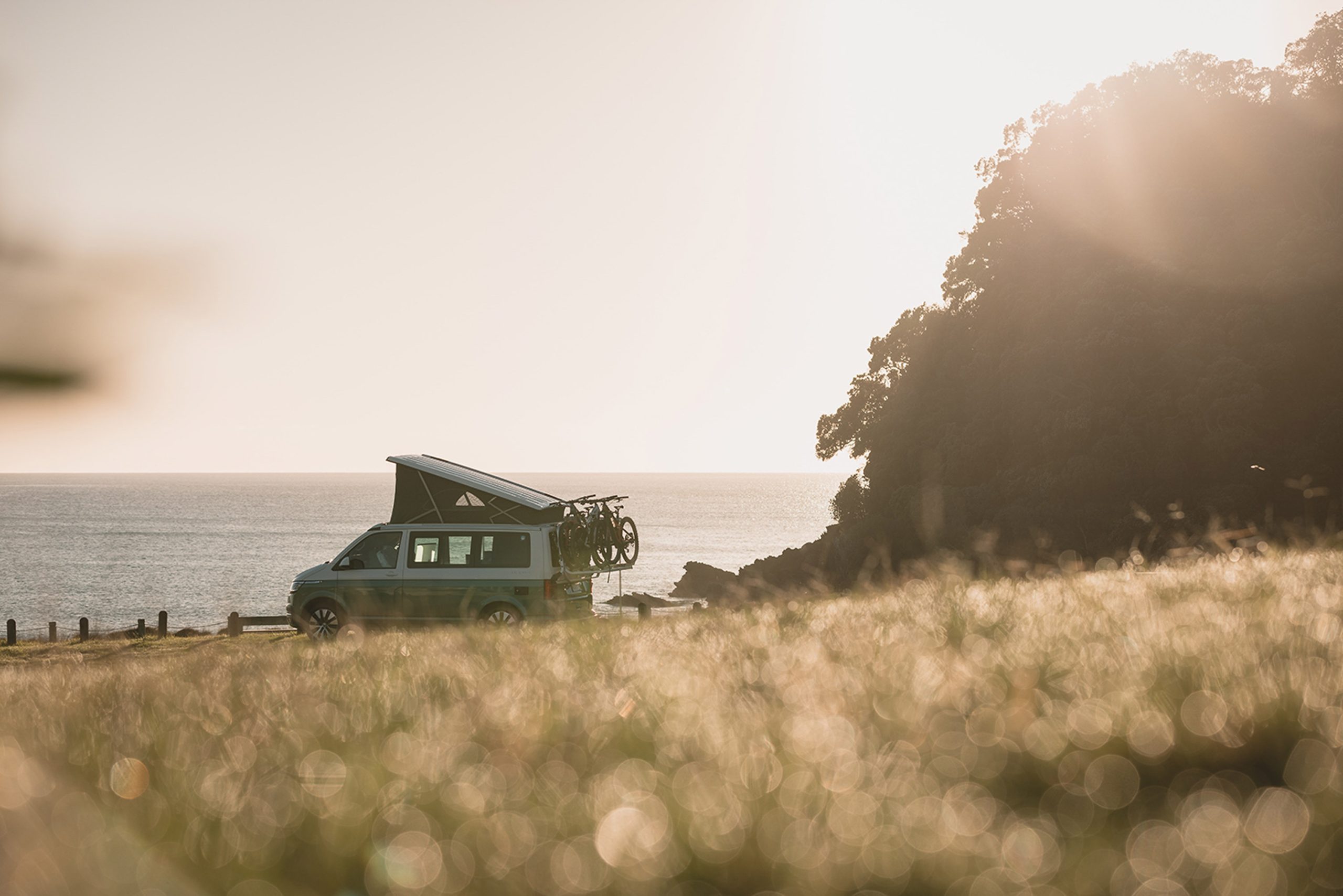
We fluffed around for 20 minutes trying to make the most of a bad situation; sessioning the bottom of Over the Falls as the curse of the dappled light once again killed our vibe. Hustling back to the van, we made a snap decision: head over the Kopu Hikuai’s and check out the trails behind Thames. But first, coffee.
Pulling into Thames, it was after lunch time, and we’d eaten all the van food. Walking past numerous secondhand stores – a couple complete with hand- scrawled posters touting numerous Covid-related conspiracy theories – we finally found a spot to eat. After a quick education from the waitstaff that our lunch of a Croque-monsieur meant ‘crispy gentleman’ (I’m still not sure that’s 100% accurate?!) we downed our iced coffees and were off to the trails.
Five minutes up the road, we rolled into the Moanataiari Mountain Bike Trails. One of the best things about the California is that it features 4MOTION AWD, meaning it can handle off-road driving to slightly more secluded spots – and secluded this was.
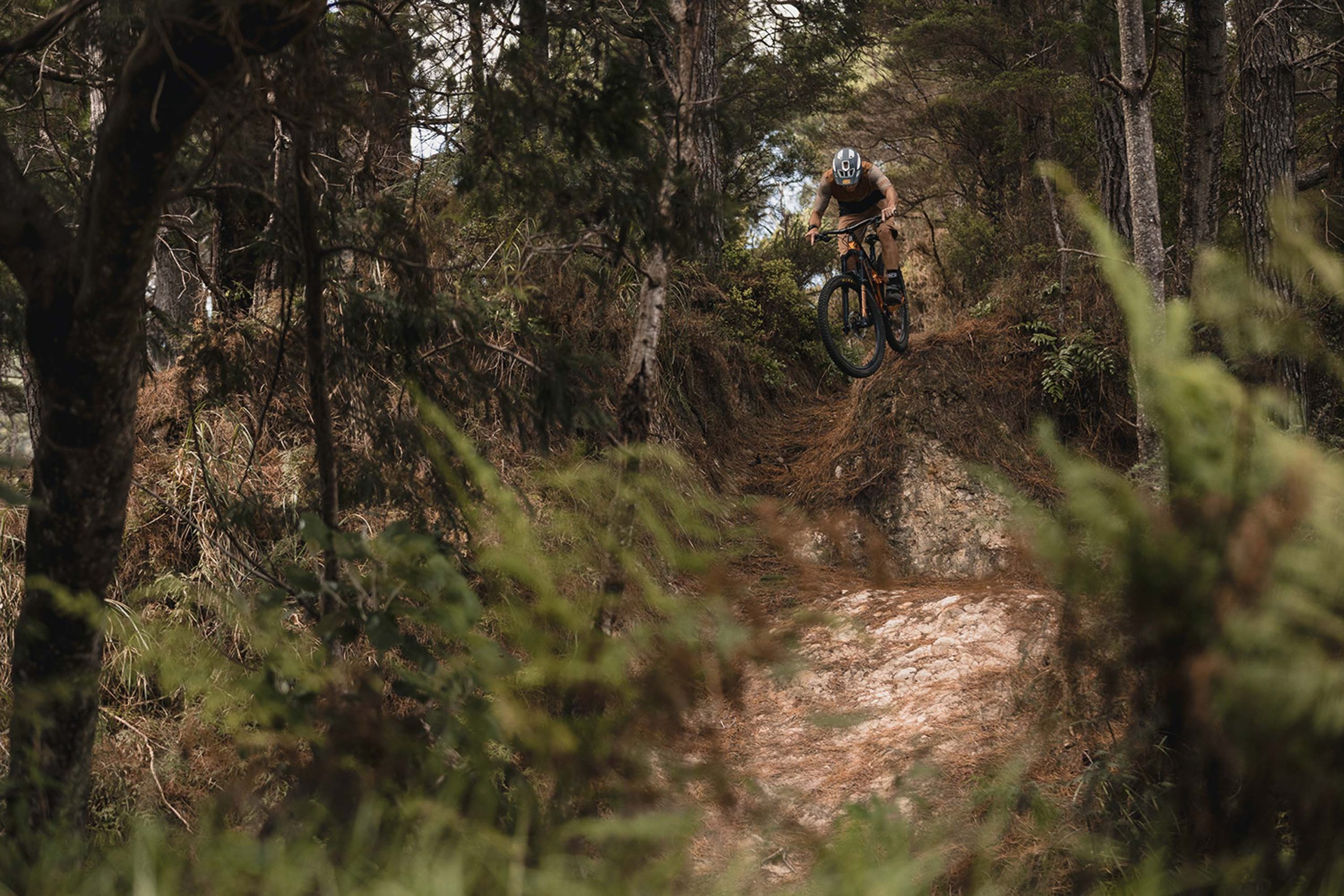
It was pretty obvious this was an old mining area with mining works visible right from the carpark, and signs warning not to stray from the tracks as mine shafts lurked in the bushes. We had no idea what to expect but armed with the Trailforks app, and a photo of the map at the trailhead, we stumbled around, finding our way. This is one of two key trail areas near Thames, the second a few kilometres out of town up the Kauaeranga Valley road. Given a little more time it would be easy to hit both areas, as well as the single 6km Karaka track, in half a day.
The Moanataiari Trails are accessed off a gravel road which, after a short climb, pops you out at a nice pump track – although why you’d venture this far up the hill with a pump track-suitable bike, I’ll never know. The ‘Hundred Acre Wood’ beginner trail winds its way around this pump track plateau, and a number of trails either drop onto, or begin their descent, from here. The park packs a lot of fun into a small number of trails. There are no big climbs or equally long descents, but there are a handful of flow trails with some super fun sections; pop this, gap that, rail that turn, charge the roots – that sort of stuff. The ‘Pit Fall’ trail has a nice drop at the end; an overhead-height gap over another section of trail. I’d not hit anything like this for a while and, after a couple of run ins, I plucked up the courage to hit it. Such is the beauty of a small-town trail centre – they’re able to build some of these more ‘risky’ features (much like the Whangamata rock-roll) which you wouldn’t find on a regular ‘legal’ trail at, say, Rotorua’s Whakarewarewa for example. I guess with less traffic there comes less opportunity for people to wreck themselves.
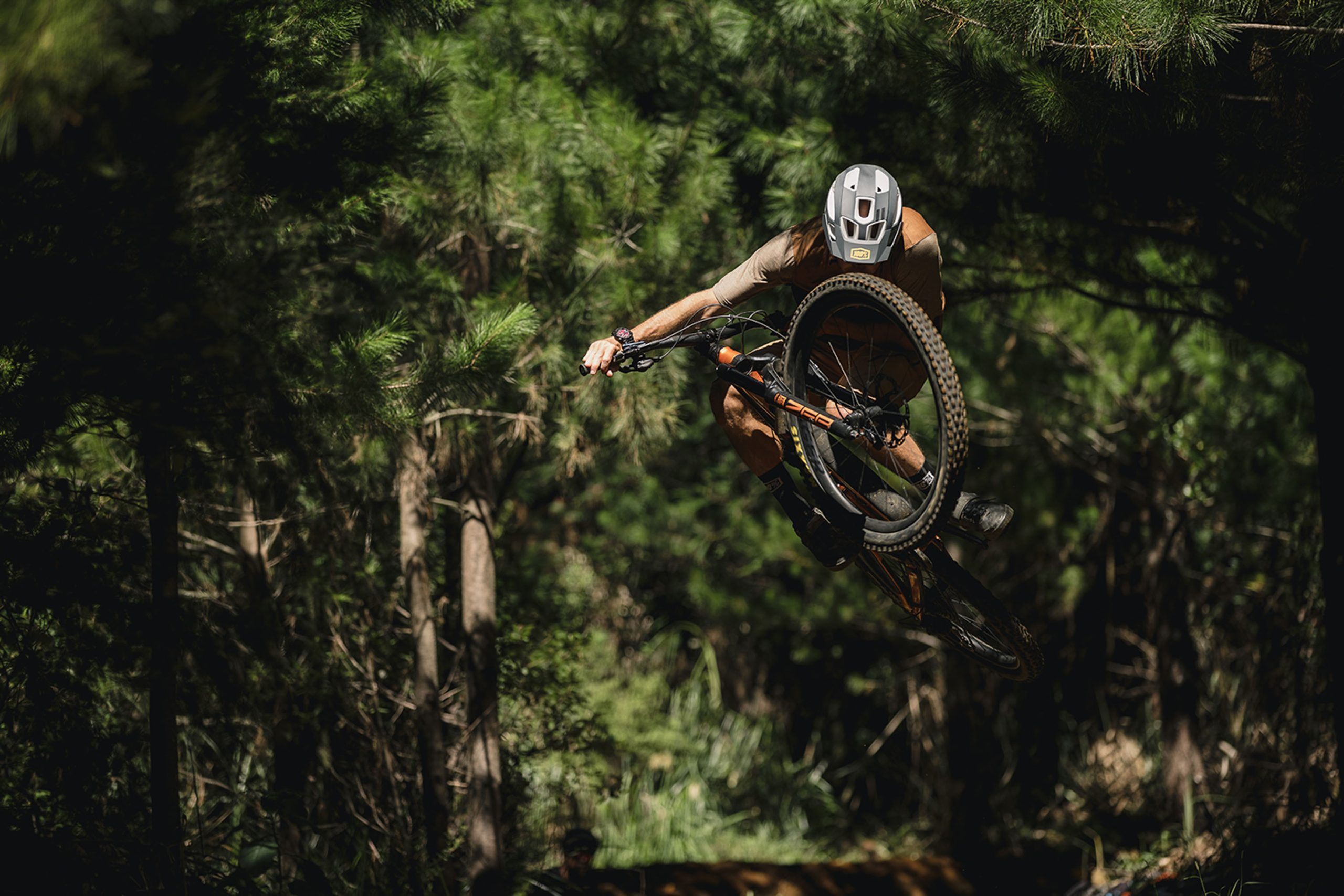
Rolling out of the trails and back to the van, we fist-bumped a successful session and loaded the van for our trip home. On the road for only 32 hours, and having no real plan or reservations to turn up for, we felt as though we’d been away for a long weekend – such is the vibe you get from being in close quarters with your travel companions the whole time. There’s no retreating to your room to doom-scroll the socials, or TV to demand your attention. The feeling of having flexibility to change plans at the drop of a hat, go wherever, stay wherever (within the local rules of course) and – if you’re lucky – waking up able to ride trails right from your front door, simply can’t be beaten.
Words: Lester Perry
Images: Cameron Mackenzie


